

IPC Magazines Ltd. 1971
Just looking at Alvin Lee
is enough to stop you in your tracks, he's devastating
with his thick blond hair, hazel eyes and tough
physique which is one very good reason why he's
probably as well known by name as Ten Years After.
He's the "face" of the
group, the one whose photo all the fans want and who
gets singled out for publicity, which Alvin seems to
think is a bit of a drag. He'd much rather people
thought of him as the brilliant guitarist that he is
rather than "just a pretty face". On the subject of
the way he looks Alvin says: "I was very paranoid
about it at first, it started in America where the
very business-like publicist we had over there found
people were picking up on me and decided to exploit
the situation. That led to a weird feeling about it in
the band....but finally we sat down together and
discussed it and it was decided that if it was going
to help the band we would let it go, but I've never
really liked to think of the band as anything other
than a band".
Since then, the whole
thing has snowballed--with Alvin developing into
something of a cult, especially with the group's
younger fans, and the film Woodstock did plenty to
swell their ranks, because Mr. Lee somehow seemed to
be the "star" turn of all the footage shot at that
memorable venue. That certainly has a whole lot to do
with his face as well as his dexterous hands and his
sexy voice. So much so that recently he has been
subjected to a selection of film offers, mostly from
the states, to further his
career as an actor. But Alvin just doesn't want to
know. This is because he loves guitar playing and
among the connoisseurs of the music world he has been
called " the last of the great British guitarist" and
earned the nickname Flash.
His present popularity is
a long way from the beginnings of the band. A few
years back Alvin Lee, Leo Lyons and Ric Lee started
playing round Nottingham, they had lean times until
they moved to London, and did a lot of session work
that got the group together on musical experience.
Then Chick Churchill joined them on organ.
On stage they finally
talked their way into a date at the Speakeasy and that
was how Ten Years After started to
become well-known.
Afterwards they hit States
and became really red hot musical property. Now at
last they have the recognition they deserve in Britain
as well. As well as playing lead guitar like an
earthly angel and singing in the same sort of vein
Alvin is the member of the band who gets things moving,
the one with the ideas. He works very hard at writing
songs which he admits he finds hard work, luckily for
us the results are always worth the effort.
Nowadays when he's not on
the road he spends much of his time at his Berkshire
country home experimenting with good sounds and
editing his cine films.
When you're one of the
budding legends of the 70's it's nice to have
somewhere where you can get away from all that
snowballing fame.
The beautiful back-page
pic of the irresistible Alvin (in glorious color!)
almost does justice to his colorful character.
Well worth a spot on your
wall I'd say..... Georgina Mells
|
|
From The Rock
Journal 1971 – By Teacher, Author
 and
Journalist Jim O’Donnell and
Journalist Jim O’Donnell
Edited by Dave
for use on our website:
It’s exactly
one year ago this summer that the Woodstock movie made
a teen idol out of Ten Years After’s guitarist Alvin
Lee. You may recall that the blonde twenty six year
old Englishman flashed his ES335 Gibson guitar under
the camera light so fast, that it looked like a
re-take of the Wilkinson Sword Blade television
commercial. He improvised an eleven minute rendition
of their encore hit called, “I’m Going Home”. With
such blazing velocity in the mid – August heat that he
all but turned the Woodstock stage into a working
toaster.
When the
lights came back on after the movie version, you
expected the screen to look like burnt toast. It was a
super-nova act, to be sure, so astounding a display,
that the guitarist managed to accomplish more than
just hold his own in a film that also included among
others:
Jimi Hendrix,
Johnny Winter, Pete Townshend, Leslie West, Carlos
Santana and Paul Butterfield. But, what all that
speed-fingering and guitar lashing on a movie screen
did to Alvin’s reputation, was to recast him from an
exceptional guitarist and good overall musician, right
into superstardom – automatically. Instead of
being simply known by a considerable loyal underground
following, as a proficient free – form – cooking -
lead guitarist, he’s now perceived by millions as a
formidable guitar hero. Along with this
notoriety, overseeing and overbearing arrogance, that
goes along with the title. Images of course never have
enough regard for facts, and the fact of the matter is
that, Alvin Lee the person, bears no resemblance to
Alvin Lee the guitar god of stage and now screen.
I once handed
him an advertisement from a rock newspaper and told
him that maybe he should look into it. The advert
said: “Learn To Play Guitar the Chet Atkins way!
Complete for just $2.98 with postage included.
According to stereotype, he was supposed to respond to
me, like an affronted cobra. In reality, the soft
spoken Nottingham native, just laughed.
This disparity
between what a performer is really like and what
people think, he or she is like, presents a major
problem for reporters and fans. If you write about the
individual that lurks behind the image, you will
usually produce a picture of a pleasant, polite and
decent person who just so happens to have one or more
outstanding talents. As is the case with all the
members of Ten Years After who are equally
multitalented, and have a multitude of tricks still in
their bag.
This interview
between Alvin Lee and myself took place on Monday
August 9, 1971 in New York City. The Friday before
this interview, Ten Years After performed at Gaelic
Park in the Bronx, after just returning from a three
month lay-off. The bands brand new album is called, “A
Space In Time” and had just been released.
Question:
How did you feel about your show at Gaelic Park the
other night?
Alvin Lee: “We
had a lot of rough spots because it was the first live
gig we had done in about three months”.
Question:
How come you took three months off from touring and
recording?
Alvin Lee: “We
were turning into a performing jukebox really. We
didn’t have time to get into new stuff and we were
just repeating ourselves. A lot of the solos, instead
of being jams, they were getting to be the same every
night”.
Question:
Did you try to do anything special with this new
album?
Alvin Lee: We
spent a lot more time on details, quality and such. We
took a lot more trouble. We’ve done seven albums. I
don’t think we’ve ever reached what we’re trying to
do, but I know we’re getting nearer”.
Question:
How did you feel about your part in the Woodstock
movie?
Alvin Lee: “
It’s the old celluloid thing – as soon as you get into
the movies, then something else happens, people
freak-out and think “Film Stars” and it’s not really
what we’re about at all”.
Question:
When years ago you first started doing your own kind
of music, as opposed to whatever was popular at the
time, did you have much trouble staying original?”
Alvin Lee: “We
didn’t have any conviction about it. We were
floundering. We were playing and often did think,
perhaps we’re barking up the wrong tree. We knew
enough to know that we were into something valid,
musically, but there just didn’t seem to be any way of
finding the market for it at the time”.
Question:
Do you practice much?
Alvin Lee “You
can always play a bit”.
Question:
What’s it like in the middle of a stage during a Ten
Years After concert?
Alvin Lee:
“You’re not out there thinking how cool it is, or how
groovy or anything. You’re just out there working
really. That’s all I ever do”.
Question:
How about audience riots when you’re playing? How do
you feel onstage during something like that?
Alvin Lee:
“It’s just a nasty position to be in and it makes me
sick that I can get into that position”.
Question:
Any plans for changing your show?
Alvin Lee:
“What we’re hoping to do now, is to try and turn on
the young people that want to come to our concerts, to
what we believe in, you know, listening and picking
out the subtleties of free-form expression, et-cetera,
rather than just dropping downers, drinking wine and
freaking out to rock `n´ roll”.
Question:
Did you once say that you would like to get rid of
that part of your white heritage, that seems to
inhibit you?
Alvin Lee: “It
definitely inhibits you by being white. I’m not so
inhibited now. I’ve worked it out a bit”.
Question:
Do you think rock `n´ roll will last forever?
Alvin Lee:
“Rock `n´ Roll is just a beat to the music. That can’t
die because it’s always there. If you only tap your
foot to it, that’s the relevance”.
Question:
Did you join Elvis Presley’s fan club?
Alvin Lee:
“Yeah, I did do that”.
Question:
What kind of mail does Ten Years After get?
Alvin Lee:
“Oh, we get some incredible letters. There are the
Japanese letters, the humble type of letters they
write from Japan, like – “will you grace us with your
presence”? Then you get the American ones saying, “Hi,
I’m stoned on THC and I’m listening to your record.
Far Out”! Ramble, ramble. And then you get the English
(British) ones saying, “I’m very interested in modern
music and I’d like to know – a, b, c, d, - and they’ll
have a list of questions”.
Question:
One last question, you always save your highest
powered numbers for the end. How come?
Alvin Lee: “It’s the ideal climax. You can’t have
subtle sex without an orgasm at the end.! |

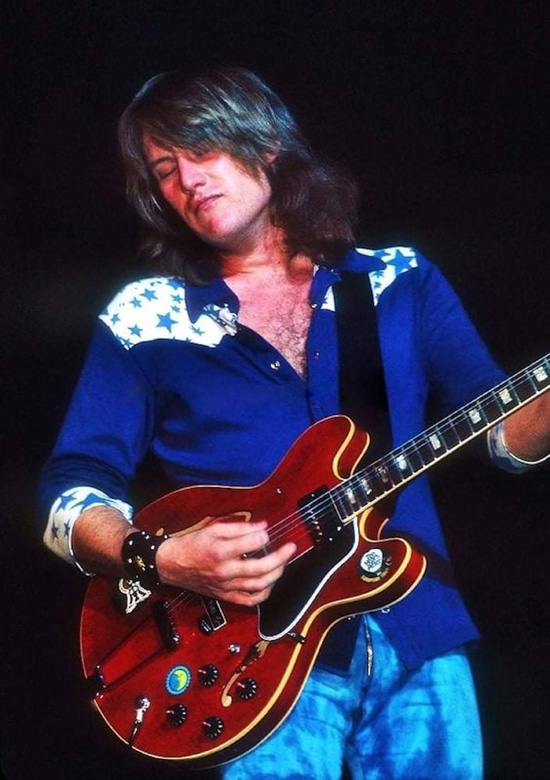
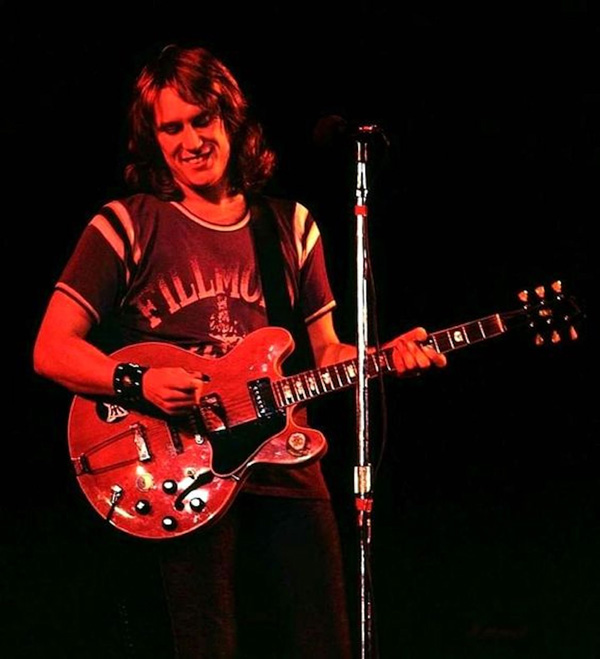
The photos above
are contributions by Christoph Müller (thank you
Christoph)
|
AUGUST 7, 1971 -
DISC And
MUSIC ECHO
6p – USA 30c
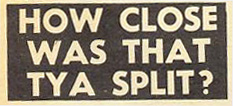
It is now
almost exactly ten years after the bass / lead guitar
partnership started between Alvin Lee and Leo Lyons; a
partnership that has weathered a lot of strains, and
knocks. The current line up of Ten Years After has
been together for about four years, and the
extraordinary part is that they’ve come a lot nearer
to splitting through fame and fortune than they ever
did in poverty with audiences booing them. In the old
days, Leo Lyons used to ring up for the bookings and
never let on he was the bass player, and they couldn’t
afford an agent.
More often
than not, when they’d done a gig, the promoter would
shake his fist at them and scream, “it’s bands like
you that are ruining the ballroom scene.” Ten Years
After sailed through hardships like that. It wasn’t
until the beginning of this year when they were all
wealthy enough to retire, they came to the point of
splitting. It might have been partly due to the
element of struggle and fighting towards a goal being
removed that weakened them, but the main problem was
the audiences. “The thing was that we built up such a
reputation, that as soon as we walked onstage, people
were reacting to what they’d heard we did rather than
what we actually were about to do. People didn’t sit
there for what we did and then react; we weren’t
communicating anything. “It got to the stage when it
felt as if we were going on and doing an imitation of
ourselves. We couldn’t work out why we were going
along and playing a 20,000 seater. Was it for the
money, or was it because we were enjoying it?
Musically we were just repeating our popular stage
numbers. “So we took some time off and thought about
it and tried to get back some of the feelings we had
in the early days. We must have come nearest to
splitting then; lots of bands split there, Cream did.
Now instead of going on and playing what people wanted
to hear, we do what we want.”
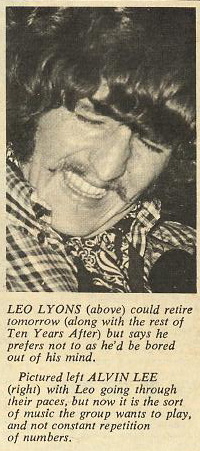
Leo Lyons was
talking at his beautiful rural home in Bedfordshire,
sitting on a mound at the top of the paddock watching
his three horses graze. It’s hot and it’s peaceful and
their tenth tour of America starting this week, seems
an eternity away. You wonder why Leo doesn’t retire
for good to this haven, when financially, he doesn’t
need to play another note for the rest of his life.
“Because I’d get bored out of my mind, and because we
really do enjoy playing live,” he says emphatically.
“Firstly you do it for love, then you get addicted to
it.”
Having toured
all over the world now, the group want to concentrate
a little more on their albums. In the past they’ve
been in the habit of rushing into the studio between
tours and doing a quick album. Their new one just
finished, called “A Space In Time” was much more
thought out and leisurely. “The trouble in the past
was that we’d put down a number in such a hurry that
three months later, after doing it onstage, the stage
version was much better than the album one. We’ve
never professed to be an album band, though, always a
live one.
The most time
we spent on the other albums was three weeks, and some
of the numbers we hadn’t played until we got into the
studio. This album, we had two numbers we’d played
onstage over the last couple of tours, and the rest
were untried stuff, but we spent quite a bit of time
rehearsing. We’ve never had a gold album and I think
that’s something that we’d like to work towards in the
future. “We’ve worked places in America to a sold out
concert and the number of people in the hall was about
three times the number of albums we’d sold in that
area, despite the fact, that the cost of the tickets
was more than the cost of the album.”
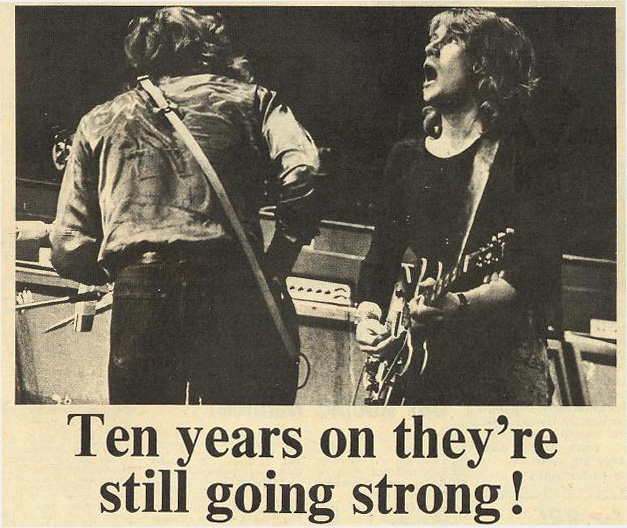
In the past,
the group was adamant about singles, now they don’t
mind too much whether the record company puts one out
off the album because, says Leo, the tracks on this
new album are far more representative and would stand
up to being singled out. Alvin still does the majority
of the writing, although Leo writes at home for his
own pleasure, but he doesn’t think he’s done anything
worth presenting yet. Leo is also into recording at
home and has converted one of the attics into a
studio. “On the “Stonedhenge” album we all played
wrote and did something ourselves but that’s the only
thing I’ve ever written that’s been recorded.
We all do bits
to Alvin’s songs. He comes along with a rough tune and
we throw it around. We might even change the rhythm
and the concept of it.”

From
travelling with their equipment in a 15 cwt. truck –
Ten Years After now travel in a cavalcade of cars with
the equipment, handled by three permanent roadies,
travelling in a five ton truck. TYA are one of the
most highly paid bands in the country (England). After
ten tours of the United States they could still work
non-stop there for a couple of years and fill every
gig. “A lot of people reckon we’re overpaid.” Says Leo
thoughtfully, surveying his
house, his land, his cars and horses, “but when you
work out the short span of time in which we’ll
be earning and spread that money over a working man’s
earning life, we work pretty
cheaply really.”
CAROLINE
BOUCHER
On The Scene
Page of this paper:
“Ten Years After’s Leo Lyons a great collector of
antique guns and Wild West paraphernalia. He’s even
erected his own stables.
|
|
Record
Mirror August 7, 1971
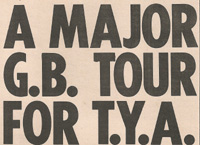
Ten Years
After will play their first British dates in over 18
months in September, and an album is set for release
to co-inside with the tour. The 10 date tour covers
every major city, apart from Glasgow, and the London
venue will not be announced until next week.
Ten Years
After’s last London gig, at the Albert Hall, ended in
their being banned from the venue and it’s this ban
which has resulted in this difficulty, of fixing a
London venue.
The full dates
are: September 14th Colston Hall,
Bristol,15th Philharmonic Liverpool 16th,
Cith Hall Newcastle 20th, Guild Hall,
Southampton 22nd, De Montfort Hall
Leicester 24th, City Hall Hull 25th,
Empire, Edinburgh 26th, Free Trade Hall
Manchester 28th, City Hall Sheffield
October 4th Town Hall Birmingham.
The album, the
group’s long awaited follow-up to their “Watt” album,
is titled
“A Space In Time” and will be released in September,
although no exact date has been finalised. This is due
to the label destination of the album being uncertain.
Ten Years After are currently in the States and “A
Space In Time” will be issued there in advance of the
British release. It’s the bands first album for the
Columbia Record Label.
|
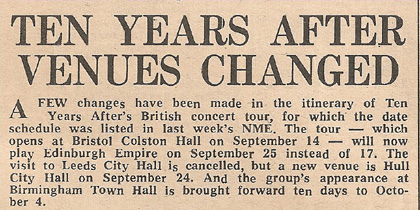
New Musical
Express August 7, 1971
|
New
Musical Express August 14,
1971

Ten Years
After – Banned from the Royal Albert Hall two years
ago, has fixed alternative London dates for its
British concert tour, which opens at Bristol Colston
Hall on September 14th. The group will play
a special midnight concert at the London Coliseum, the
first outfit ever to do so. On Saturday September 18th.
And to ensure that it caters for as many people as
possible, Ten Years After will play an additional date
at the Coliseum the following evening at 7:00 pm. The
Remaining dates for the group’s tour have already been
reported in the New Musical Express. Ten Years After
is currently touring America, where their next album,
and the first to be released on Columbia Records in
the States, is due out immediately. The L.P.
is
titled, “A Space In Time,” and will be issued in
Britain next month. |
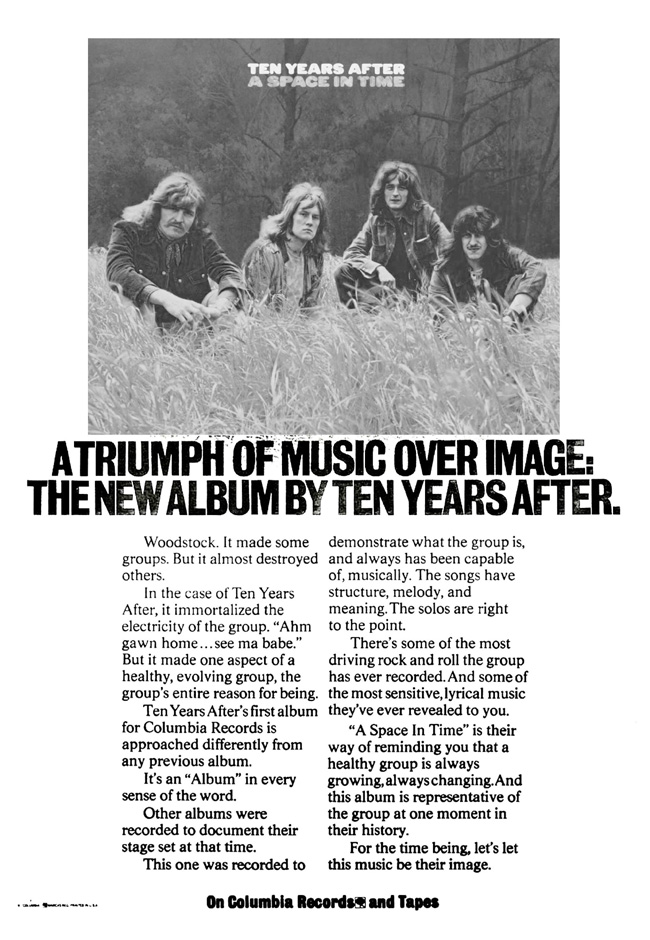
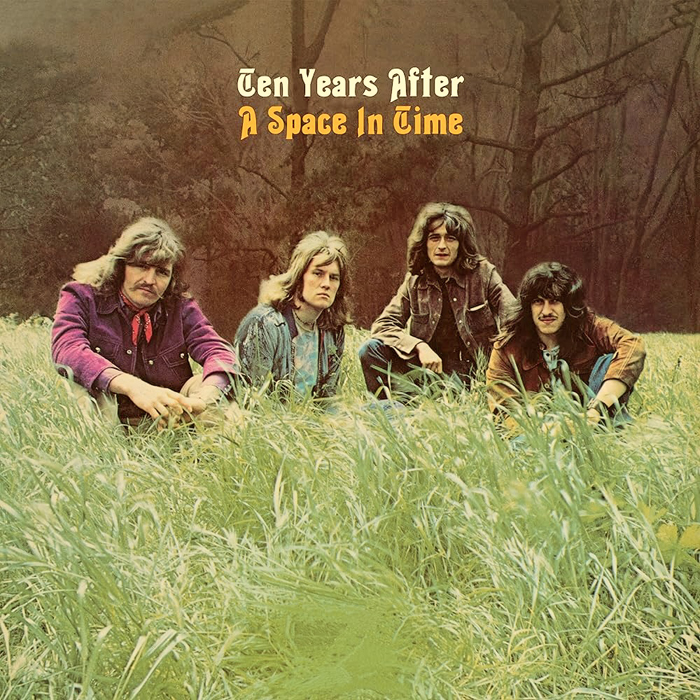
August
1971 - Release of "A Space In Time"
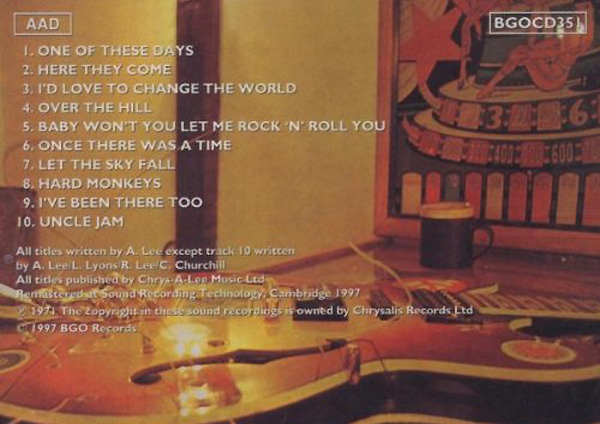
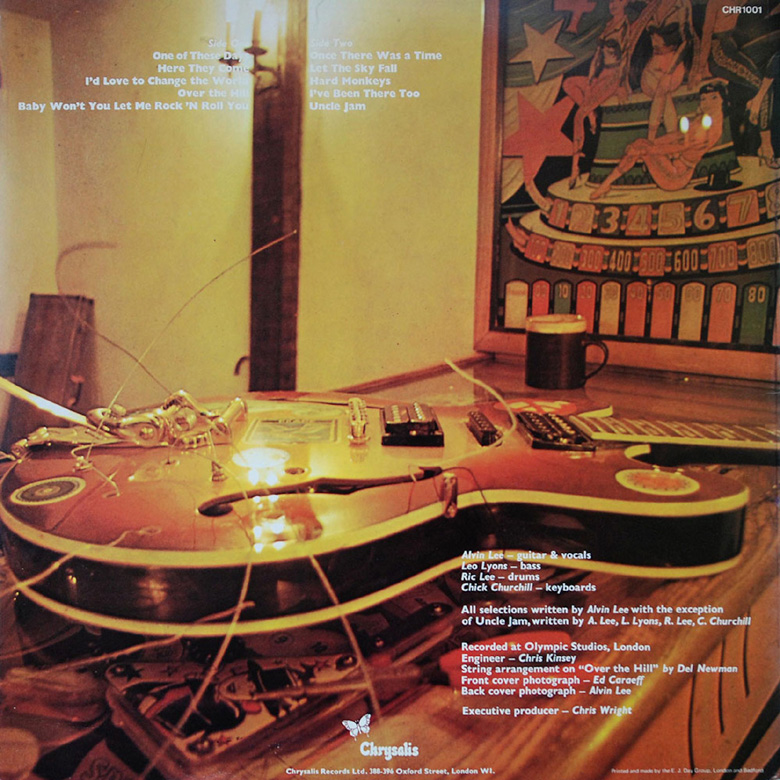

Ten Years After 1971 -
Photos above and below by Ed Caraeff
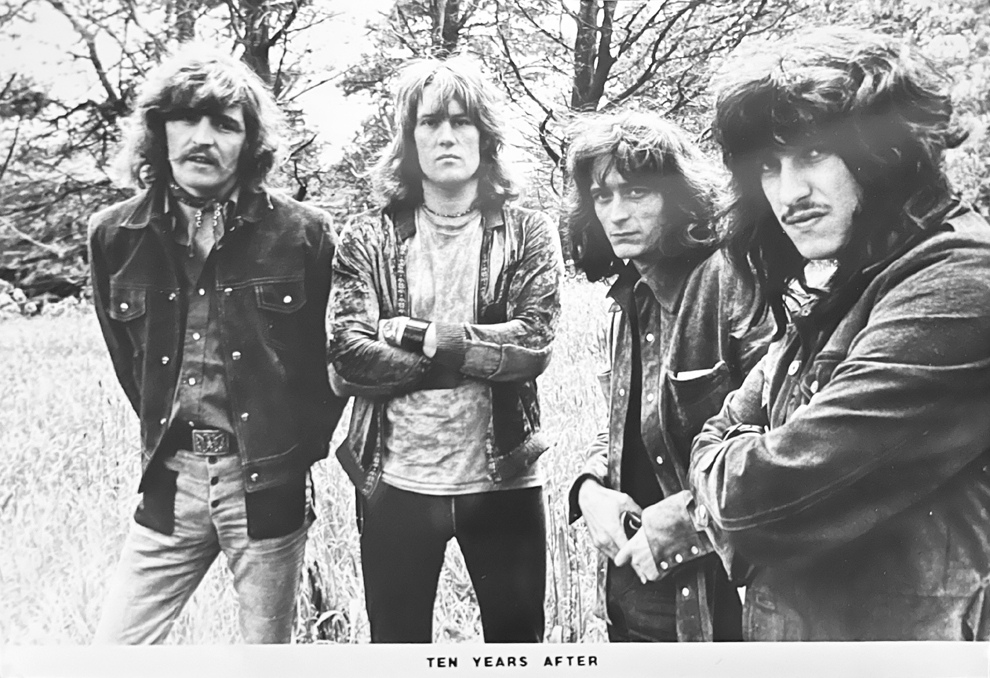
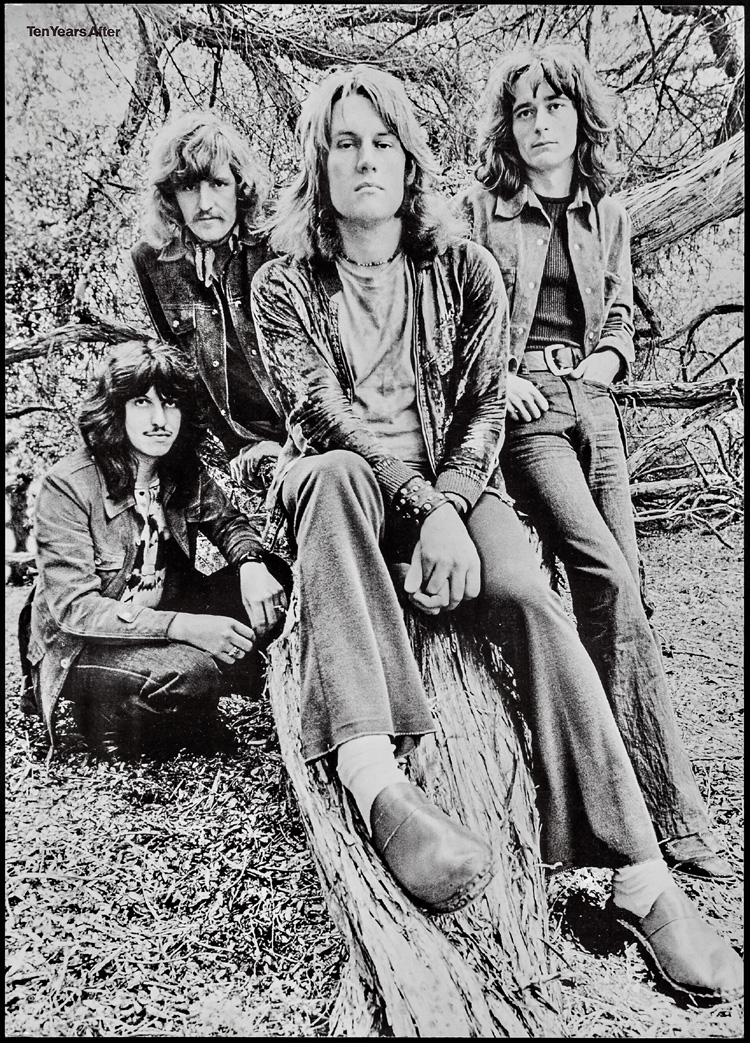
1971 -
TYA "A Space In Time" Photo Session, Photo: Ed
Caraeff
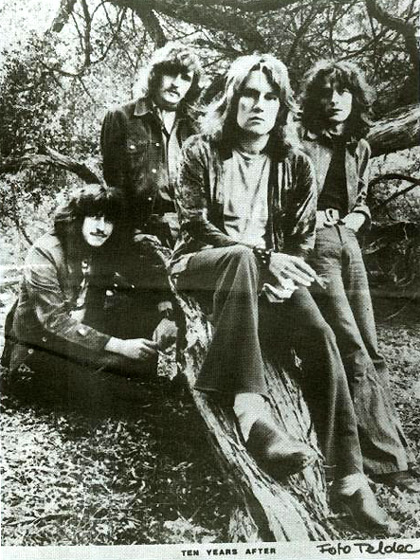


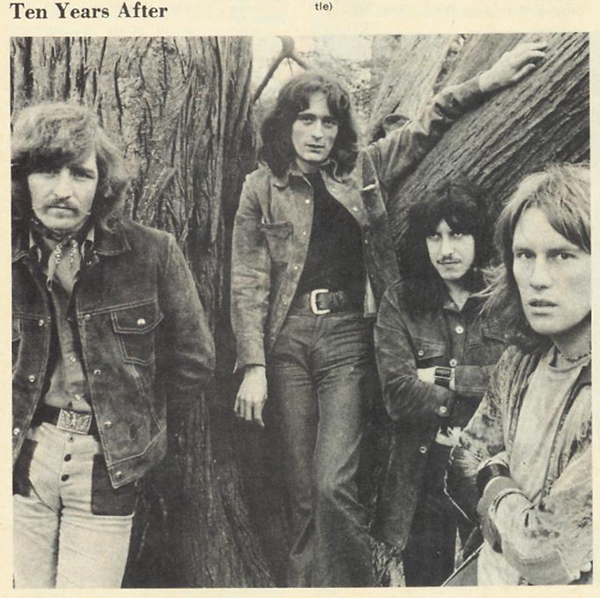

1971

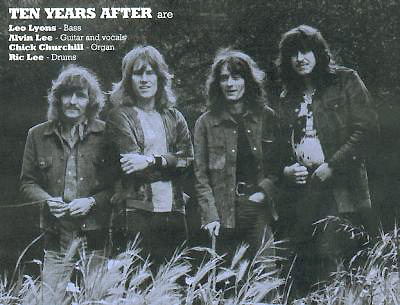
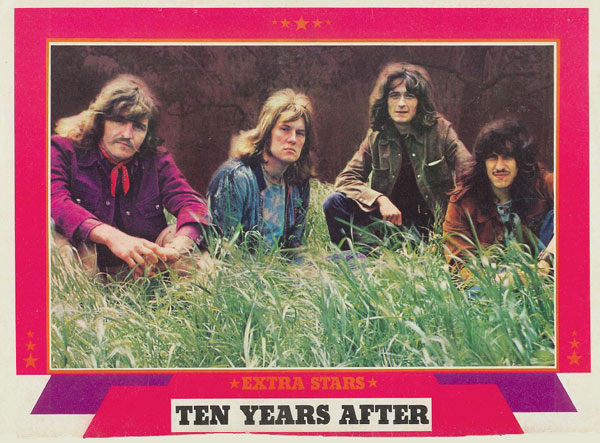
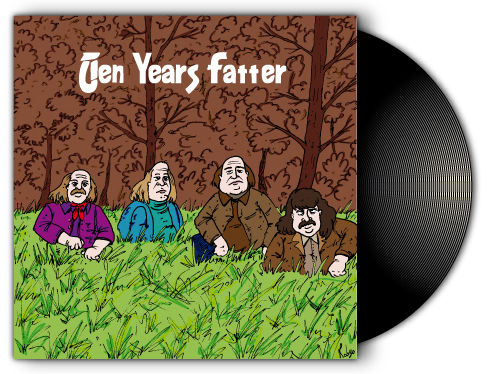
A Very Funny Find - Guaranteed to
make you smile - or even laugh out loud!
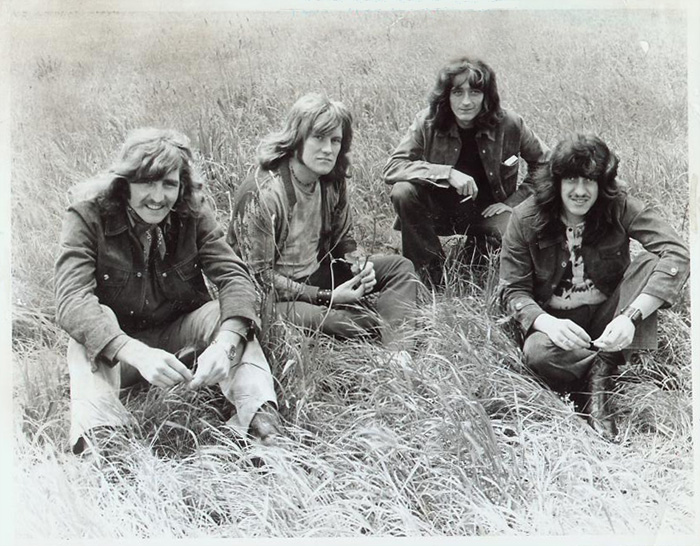
Original Press
Photo from the "Chicago Sun-Times" - Photographer: Ed
Caraeff
|

Picture contributed by Gary
Holdinghausen
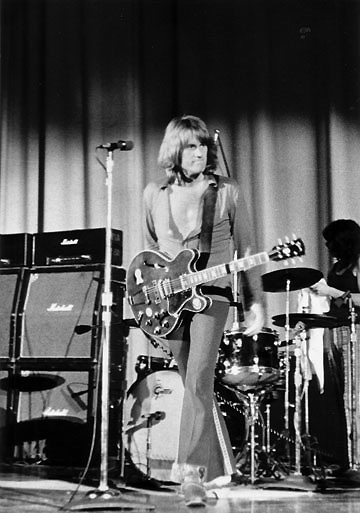
Alvin Lee
of “Ten Years After” during my St. Louis concert
that ended in a riot. Cops arrested me when I tried to
stop a cop from beating a fan with a flashlight.
Tom Karr – Concert Promoter
Former KSHE
D.J. John Williams recalling the riot that broke out
during an August 28, 1971 Ten Years After concert, at
the Kiel Auditorium, in St. Louis, Missouri.
It was after
all, a great way to make a quick hundred dollars. Walk
out on stage and announce, “Ladies and Gentleman,
would you please welcome the British band “Ten
Years After”.
Then, walk off
and collect the money. But on the night of August 26,
1971 - an apparently simple job, was anything but
simple this time. For Disc-Jockey John Williams, this
would be a night that he would not easily forget. This
was the night that a new, unknown band called J.
Geils, would be opening for the already
established and famous Ten Years After. From early on
in the set, Craig Petty was right up front, taking
photos of Ten Years After. But as Ten Years After’s
set was coming to an end, something went seriously
wrong.
The audience
wanted and expected the band to play their usual
encores, but someone behind the scenes,
unexpectedly and abruptly ended the show. “I was five
feet away from everything” said Craig “I was in
perfect position to see what was going on”. People put
a table upon the stage, people were getting pushed and
crushed against the table that was about waist high
and it got thrown on top of the crowd, by the concert
promoter. The audience didn’t do anything wrong, they
just picked it up and pushed it off to the side
and then the security guys came rushing out and
grabbed the table and threw it back on top of the
crowd, it hurt people and the rest who witnessed this
went off. We climbed out from under the thing and
headed to the back of the auditorium. We sat in the
seats and watched it all go down, we saw people
busting chairs up and throwing shit, and I think they
broke some windows around the exit ramps”. “Shoes and
bottles rained down on me”, recalled Nancy Webb, who
was sitting in the first row on the main floor. While
John Williams had a unique vantage point, of the
mêlées. “I was the hired emcee, I was paid one hundred
bucks to introduce the guys.
I vividly
remember introducing them, because I remember the
exact words that I said, “Ladies and Gentleman, Hi,
I’m John Williams from radio station KSHE – FM –
Radio, and won’t you please welcome to the Kiel
Auditorium, Alvin Lee and Ten Years After. Usually,
you would walk off, collect your money, and do what
you were going to do after that. But, there was
confusion going on, and there was a microphone and
Alvin Lee and Ten Years After, had either stopped
playing, or they were off stage, I just don’t seem to
remember exactly, I was doing my best. Then, someone
shoved me and said, “get this thing under control, or
we’re going to shut the thing down”. So I went out
there, on stage, with the ridiculously stupid idea of
trying to calm down 10,000 people. So I’m out there
saying something on that microphone, and the next
thing I know, I’m down on the floor, on the stage,
knocked out cold. I got clobbered right on the
forehead by a wine bottle, it came out of nowhere.
Somebody came and dragged me off the stage and I ended
up on a cot backstage and off to the side. The next
thing I remember, I woke up in my apartment and there
was a gigantic party going on around me, I guess I
recovered and joined the party”.
The next
morning, Jim Singer, recalled John Williams getting on
the air at KSHE and chewing
out St. Louis, he was pissed. He played a Ten Years
After song, and piped it down and asked why? He did it
over and over, remembered Jim. “It was a beer barrel
type of crowd”, said Williams, I loved that group,
they had long cuts on their record albums, and they
were British and they were great. John Williams left
St. Louis not long after this riot, and moved to
California – he worked for KZAR – Radio.
In another
accounting of the event: Ten Years After had just
finished playing their usual set and the crowd wanted
an encore. The hall management refused to allow it and
the audience became unruly. The police moved in. This
made matters worse and the whole thing turned into a
riot. I didn’t see the result because we left once the
thing flared up, but I understand that somehow the
promoter became involved and threw a table into the
audience. The police arrested him and he spent the
night in jail. The whole thing could have been avoided
had the band been allowed to play one more song.
It was this
event and one other similar incident in Queens, New
York that gave Ten Years After the reputation of
attracting unruly audiences and after that the band
had problems with municipal auditorium management,
police and fire departments, who insisted the audience
must sit for the whole show under threat of being
arrested. Promoter Bill Graham overcame the problem by
having his own security people at his promotions.
In the photo,
you’ll notice the large speaker cabinet that had
fallen in front of the stage, just prior to the start
of the riot. Just further proof of Craig Petty’s
version of how it all started.
From Alvin Lee
& Ten Years After – Visual History – By Herb Staehr
Towards the end of the show, Alvin Lee tells the crowd
to move closer. The fans storm the stage, the riot
police are called in and Ten Years After are unable to
complete the last song.
|
The following photos by Gary
Holdinghausen:
28 August 1971 - TYA at
Kiel Auditorium, St. Louis, Missouri
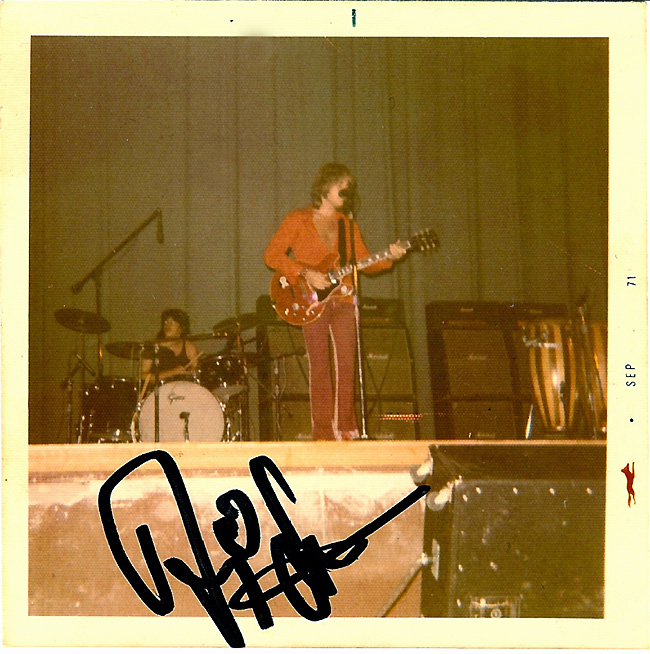
Many Thanks to Gary
Holdinghausen
for sharing these rare, beautiful
photos with us
"I have a few pictures of TYA in St Louis
that I took in 1971, at my 1st TYA concert.
They were taken with a cheap instamatic 110 camera
– with no flash.
At this concert there was a
riot that started when Alvin ask the audience to
come closer"



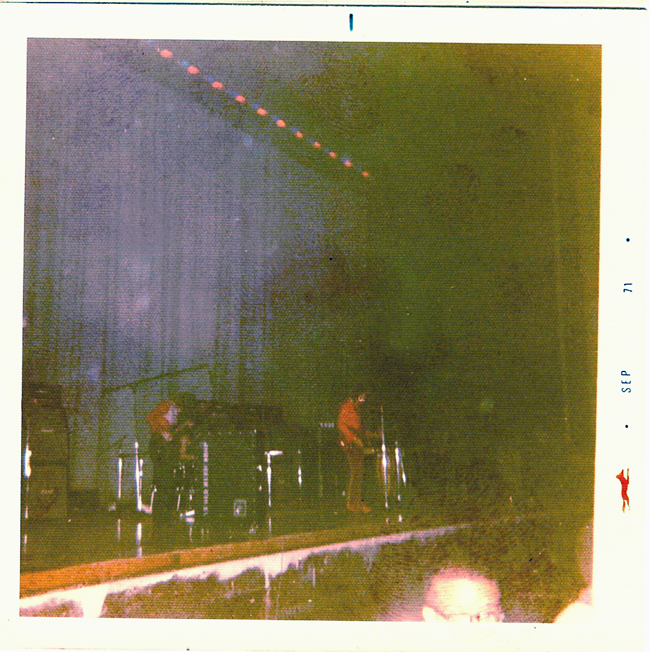

|
|
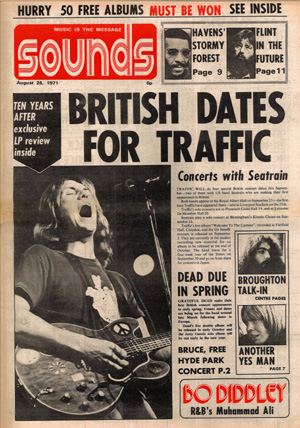
SOUNDS MAGAZINE - AUGUST
28, 1971
An
exclusive review of the new Ten Years After album
“A SPACE IN
TIME” and their opening U.S. concert.
CONCERT
REVIEW:
The young lad
had carried the watermelon from home and finally
tucked it between his legs and waited for the end of
Ten Years After’s hour and a half long set. Finally,
after the encore, the long-haired youth gave the
watermelon to the equally long-haired security guard
in front of the high stage. He reached up and rolled
it behind the amps, where it came to rest at the feet
of Ten Years After. That was the way one out of a
crowd of 12,000 showed his thanks, the other 11,999
simply stood their ground and roared for ten minutes;
finally after a few last “yeahs,” they started on
home, leaving much excitement hanging in the warm air.
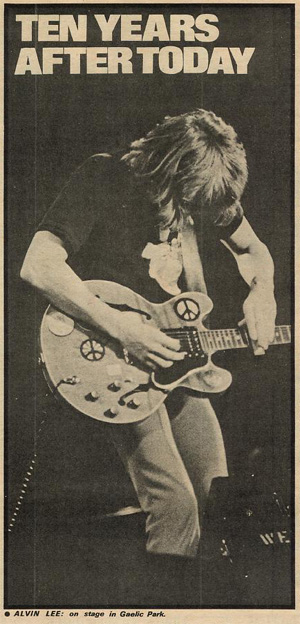
This then was the way Ten Years After kicked off
their latest American tour, and it’s not bad having
12,000 people come to see your concert. The scene of
all the excitement was Gaelic Park, which is in the
upper reaches of New York City, just north of the
point where Manhattan turns in the burro of the Bronx.
Gaelic Park is a soccer-rugby field, owned by
Manhattan College, and has been the scene of some
really fine concerts this summer.
EXCITING:
The concert
had a festive if not festival feel to it. Many of the
audience carried heavy picnic hampers (baskets) full
of food and liquid goodies. For a brief few seconds
the scene resembled the Woodstock Festival two years
ago, except this concert lacked the other 400,000
people present at Woodstock. The audience had come to
see Ten Years After without question. Many simply
arrived minutes before Ten Years After took the stage,
missing the balance of Edgar Winter’s fine set. Over
8,000 tickets were sold up to the day of the concert,
while another 3,000 to 4,000 lined up the afternoon of
the show for tickets. Despite a rash of violence that
has plagued many outdoor concerts this summer, the
audience was well behaved and respectful of Alvin,
Chick, Ric and Leo. Without question the concert was
exciting. Many bands lose whatever magic they contain
after working together for some period of time.
However, that is not the case with Ten Years After.
Even though they had not played for a few months, they
were as tight and as creative as ever. Leo Lyons bass
runs were visual to the eye and splendid to the ear as
ever.
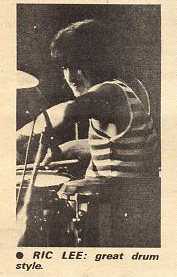
IMAGE:
Ric Lee still
has that great drum style, that puts him high above
the other drummers that are working in rock music
today. I can’t recall Chick Churchill’s organ playing
sounding better. And finally, Alvin Lee…Most of the
yells between sets were aimed at Alvin, who has the
image that most audiences want of rock guitarist.

CREATIVE:
However, Alvin
is one of the hardest-working, creative guitarist in
music today, and a fine musician. His style and drive
are beyond compare, and he thrilled the audience by
using his harmonica and microphone stand on the neck
of his guitar, much in the same way guitarist use a
slide technique. Alvin’s style and skill have grown
over the last few years, and he still sings quite
well. Many of the selections played, were from the
band’s new album “A Space In Time”. “Hard Monkeys” –
“Baby Won’t You Let Me Rock `N´ Roll You” – were the
songs that went down well, followed by an encore of
“Going Home”.

The 12,000
plus fans that came out to see Ten Years After,
reaffirmed the popularity and fine music the band is
able to effortlessly create. It’s good to see them
work, and remain untouched from the changes other
bands go through. For those that question the
popularity of the band, I can safely say it was not
owing to a mass advertising effort, rather the simple
fact that they are a fine band and discriminating
audiences as in the past have the good taste to see
them work.
By Chuck
Pullin
ALBUM REVIEW:
Ten Years
After : “A Space In Time” (Chryalis) September
Release:
Having
Reviewed the WHO’S latest album (WHO’S NEXT) on the
same weekend as
“A Space In
Time,” I’m afraid the latter must suffer by
comparison, in fact, anything the same week, (or
even longer) would suffer the same fate, and when
making assessments of any album, especially when they
are both British rock bands, this is unavoidable.
This, and the WHO and Ten Years After’s great
following throughout the world, are the only real
parallels, as Ten Years After are far more a rock and
roll band, than a “rock” band, it comes across strong
enough on record, but nowhere nearly as strong as
their live dates.
STABBING:
Guitarist
Alvin Lee has suffered a lot of abuse about his speed
and therefore lack of apparent taste, but here
there’s a marked slowing down and on the very rare
occasions that he does really let go, he handles the
lyrical and melodic angles well. The opener “One Of
These Days”, has a stabbing start, somewhat like
“Tobacco Road” and just when you think Lee’s bluesy
voice could do with a bit more volume, Chick
Churchill’s organ and Alvin on mouth harp pep things
up. Leo Lyons (bass) and Ric Lee (drums) add even more
pace and while there’s a lack of excitement, Alvin’s
controlled rolling guitar break does save face.
“I’d Love To
Change The World” is far better, much more the Ten
Years After we’ve come to expect. Acoustic guitar,
echoing vocals and electric guitar build up the tempo
with very good cool electric passages by Alvin and
while there’s nothing new developing, it’s a very nice
track.
EXCITEMENT:
“Over The
Hill” is a strangely non Ten Years After cut, with
very pleasant string arrangement with simple acoustic
guitar added. An unexpected but pleasing dimension to
the overall feel of the album with “Baby Won’t You Let
Me Rock `N´ Roll You” blasting out what you’d expect –
tough rock and roll. There’s an element of send-up in
the “period” voice, rolling piano and thrashing drums,
but the old Ten Years After excitement is very evident
in this one and you can almost see Leo Lyons hair
flapping around as he pounds out the bass lines at the
back.
Side two
opener – “Once There Was A Time” suffers a little from
the same thing as lots of the other tracks, lack of
strength or projection of Alvin’s voice, but it’s
followed by “Let The Sky Fall” where the sultry close
to the mike, sort of vocal approach pays off. The
backing is kept on a tight reign and while Leo Lyons
bass gives the track a very firm direction, it’s the
lightly wailing guitar and nice cool break by Alvin
that rounds it nicely. No tricks or high speed just a
straight show of skills.
“Uncle Jam”
shows a very positive jazz influence, with more than a
touch of Szabo Garbo electric guitar with the rest of
the band jamming like mad for the track’s quite short
duration.
It really
doesn’t need repeating that Ten Years After are a far
better live band than their albums suggest, they get
over much more of their charisma and excitement that
has a job surfacing on their recorded work.
By Billy
Walker
 |
|
HIT PARADER Sept 1971

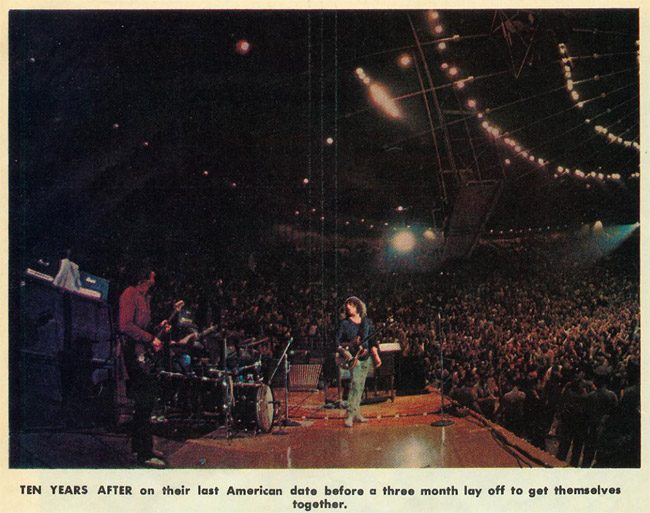
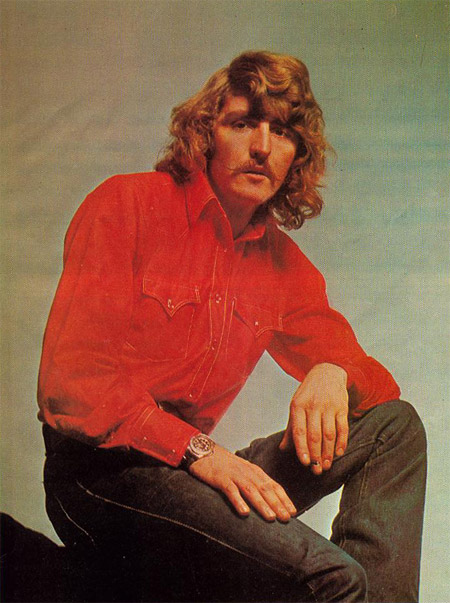
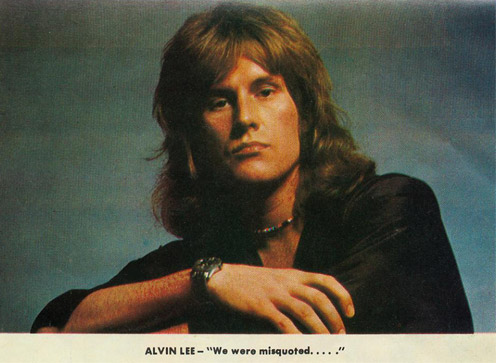
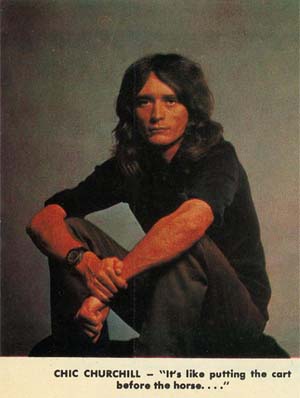
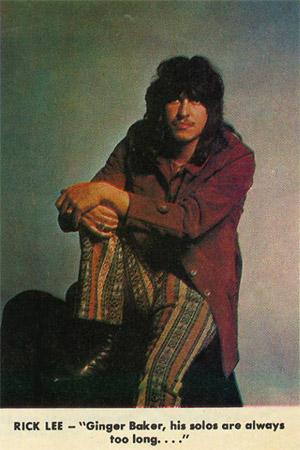
|
Ten Years After had a voluntary
lay off for a quarter of a year, following a date
in December in the States. From there they went
back home to England to “own – thing” it for three
months. The official statement was that the group
wanted to re-think its policy and get a new act
together. I was to find, following them through
the first three concerts after the lay off, in
Munich and Dusseldorf, Germany, that this just
wasn’t true. In fact Alvin Lee’s first words when
I arrived in Munich were “I hope you haven’t come
to hear our new bag. We were misquoted, we didn’t
have the three months off to do a new thing, I
spent it getting everything that went before out
of my head. I don’t know what difference you’ll
notice. We can hear each other more now. Before
we’d play our hits and think, “Right he’s going to
play such and such now”. “It got very automatic,
there was no spontaneity anymore”.
The concert in Munich, Germany
went on hours late because of difficulties
concerning erecting a stage. Ten Years After faced
a massive uptight crowd that had been kept waiting
for three hours. By the end they were on their
feet cheering. Reflected Leo Lyons afterwards on
the way back to the hotel. “We had to go down
there to the concert hall, even if it was only to
go on and talk to them, to let them know we were
there. You have certain responsibilities to be
aware of, and if we hadn’t gone on, people would
have been hurt in a riot. It’s always better to go
on, no matter how late. Most of them seemed to
think it was our fault they had to wait three
hours, there was no one to explain to them”.
Dusseldorf was better, from the point of view of
hotels and the concert hall. The dressing room was
as grand as the Munich one had been miniscule. We
were all silent for the standard procedure of
Alvin tuning up. He does so by listening
acoustically to Leo’s bass through the end of the
neck. Drummer Ric Lee was playing with a
protective finger stall. Having had a wart removed
from his fingers. After the concert I complimented
him on his drum solo. He replied, “I don’t like
making solos too long. They get boring unless
you’re Buddy Rich, and I’m not. “That’s why I
don’t like Ginger Baker. His solos are always too
long, they go on and on.
Chick Churchill had hand
trouble as well, blisters from not playing for so
long, and taped up his thumb. Leo Lyons told me,
“During the lay off, I had plenty to do, I live in
the country and I’ve got horses. I spent a lot of
time thinking about what the group would like to
do, whether to go out doing a lot of concerts and
taking the money, or record more, or what”.
“It’s like putting the cart
before the horse. Now it’s getting back to the way
it used to be.
We’ve gone way beyond what we
ever hoped for, we never thought we’d be this big.
We thought we’d get gigs and enough bread to pay
the bills. After a time you find yourself
consciously trying to live up to your reputation”.
Leo said, that on stage, the group now jams a lot
and it was obvious from all the solos. That each
member has a chance to show his paces
individually, and that the music is a lot less
restricted and stereotyped now. But Leo would like
to spend more time on records in the future. “We
spend three weeks on an album and that’s it. It’s
over and done with. Some groups, even new ones,
take months over it and I think we ought to take
more time out for recording. We’ve done six albums
and about 60,000 gigs.
The trouble is, we’re lazy”.
Article By Richard Green
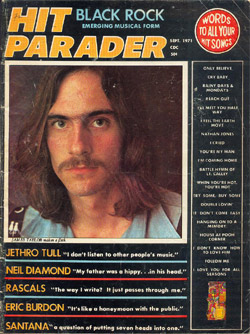
|
|
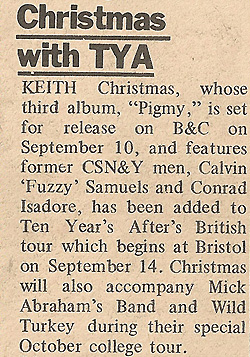
Record Mirror
September 4, 1971
|
New
Musical Express September 4,
1971

Ten Years
After have added a further date to their British
concert tour which opens at Bristol Colston Hall on
September 14th, it is at Bradford Street.
George’s Hall on September 27th.
But the
group’s visit to Scotland, Edinburgh Empire had
previously been announced for September 25th,
has been put back to October and revised dates are now
being set for Edinburgh and Glasgow. Other on the
tour, which also features Supertramp and Keith
Christmas, are at the following: Liverpool
Philharmonic Hall September 15th, Newcastle
City Hall 16th, The London Coliseum 18th
and 19th, Southampton Guildhall 20th,
Leicester De Montfort Hall 22nd, Manchester
Free Trade Hall 26th, Sheffield City Hall
28th, and Birmingham Town Hall October 4th.
The brand new Ten Years After album, “A Space In Time”
is currently climbing the American Album Charts.
|
New Musical Express - September 18, 1971
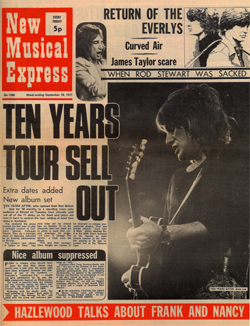

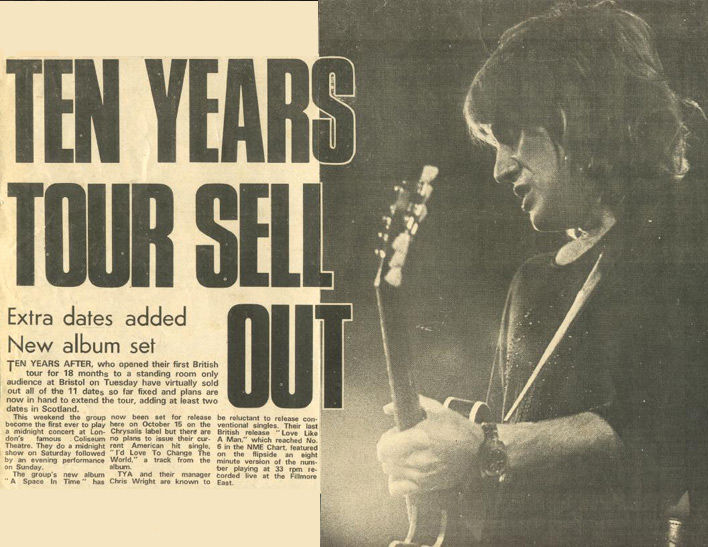
|
Ten Years After Tour A Sell Out – Extra Dates Added –
New Album Set
Ten Years After who opened their first British tour
for eighteen months to a standing room only audience
at Bristol on Tuesday, have virtually sold out all of
the eleven dates so far fixed and plans are now in
hand to extend the tour, adding at least two dates in
Scotland. This weekend the group became the first ever
to play a midnight concert at London’s famous Coliseum
Theatre. They do a midnight show on Saturday followed
by an evening performance on Sunday. The group’s new
album “A Space In Time” has now been set for release
here on October 16th on the Chrysalis
label, but there are no plans to issue their current
American hit single, “I’d Love To Change The World” a
track from the album.
Ten Years After and their manager Chris Wright are
known to be reluctant to release conventional singles.
Their last British release “Love Like A Man” which
reached number 6 in the New Music Express Chart,
featured on the flip side, an eight minute version of
the number playing at 33 rpm, recorded at the Fillmore
East.
|
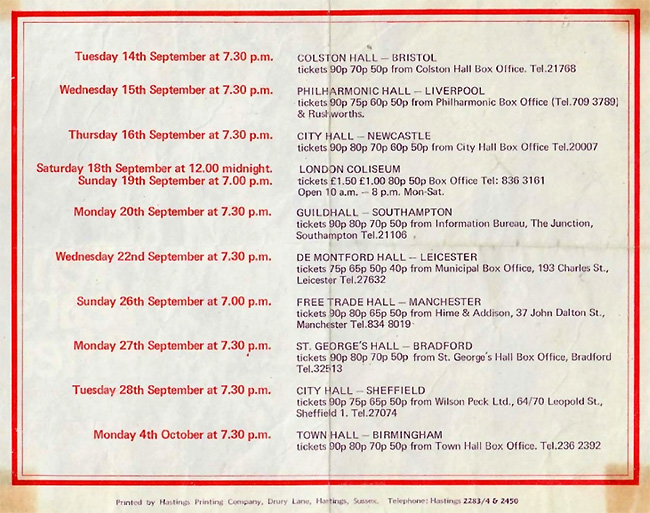
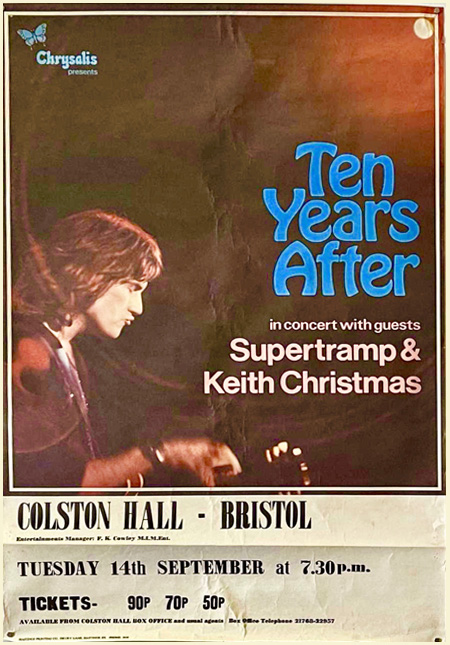
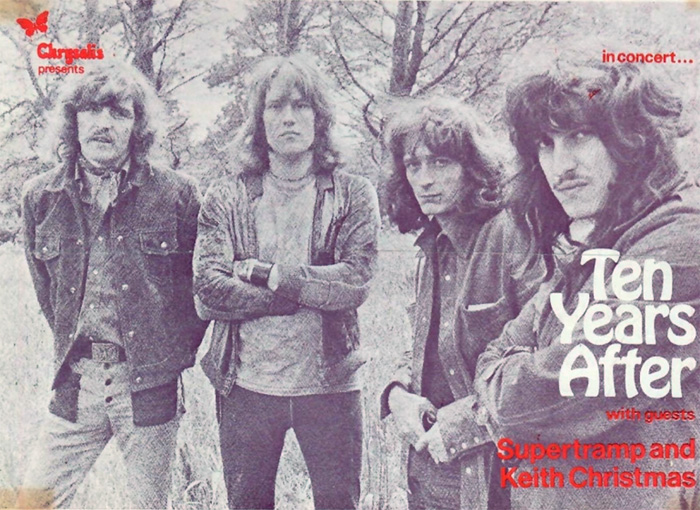
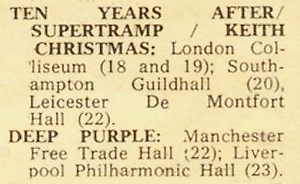
NME - 18 September 1971


|
September 18, 1971
- NEW
MUSICIAL EXPRESS - AROUND LONDON
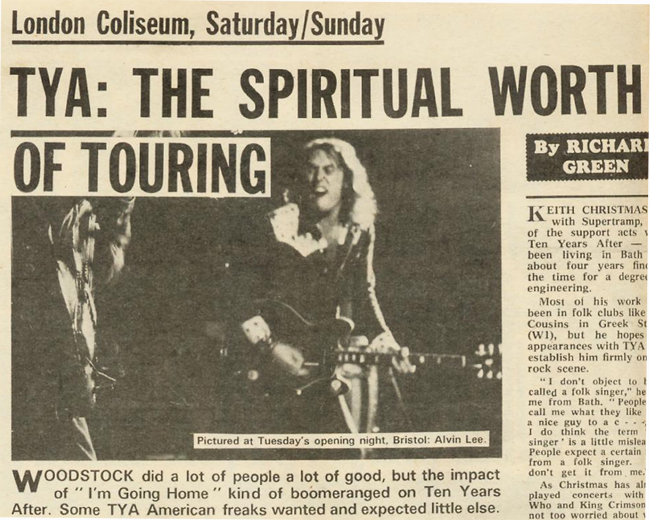
TYA: The Spiritual Worth Of Touring
Woodstock did a lot of people a lot of good, but the
impact of “I’m Going Home” kind of boomeranged on
Ten Years After. Some Ten Years After American
freaks wanted and expected little else.
A just completed US tour and the release there of
“A Space In Time” have gone far in changing
the balance, and it’s tracks from this new album
which form the basis of the band’s new act for its
upcoming series of British concerts. They open this
weekend with two dates at the Coliseum.
Not that “I’m Going Home” is being dropped
altogether. Bassist Leo Lyons is philosophical:
“Alvin and I have been doing that number doe ten or
eleven years. It’s a work-out, and we just have to
accept that audiences want it. We’re not
complaining. It’s not a case of fuck ‘em here we go
one more time. In fact, any time we’re O.K. for
energy then that number is where it goes.”
I asked him (Leo) about the rarity of Ten Years
After’s British appearances. We’re they financially
worthwhile, in terms of the size of the venues and
the number available? “No. British tours aren’t
financially worthwhile……but they’re spiritually
worthwhile, it’s great to work in England. And
though I say they’re not financially worth it, I
suppose we must make a profit eventually.
“What we’re doing really is to attempt to make a
concert tour as good as we possibly can, hence the
new PA (public address system). It’ll be really
totally satisfying to us on this tour if we can get
it all working well and present something of a good
standard.”
That Ten Years After play at the Coliseum this
weekend and not the Royal Albert Hall is as a result
of a ban placed on them by the Royal Albert Hall
management, itself as a result of crowd behaviour
the last time they played there. What reaction does
a musician have when something like this happens?
Lyons: “The Albert Hall ban was as a result of over
enthusiasm, broken seats, that type of thing. We
knew nothing about it until we were told, you can’t
tell from the stage. We could have turned round and
said it was the fault of a minority of the audience,
it was a good concert. It felt good, the audience
was good and we played good. So my reaction is fuck
the Albert Hall.” “It’s disappointing, because it’s a nice place to play and
it’s nicely situated for people to get to. You’re
not left with much alternative , other than in
places that look and feel like railway stations. I
feel that in the Albert Hall, wherever you sit you
get a reasonable sound and a view of the stage.”
With the tour now about to move on to the road and
the time lag since the last album I asked when “A
Space In Time” would be out there. “I think it’ll be
released any day now but I don’t even know which
label because we’ve just changed record companies.
Yes, they’re all Alvin’s numbers, aside from the jam
we did. He’s excelled on this album, he’s written
some stuff which is far better than anything he’s
done before.
“We put more time and effort into this one. Some of
our albums, we’ve done in three weeks. A lot of the
material we rehearsed and played in the studio, and
after we’d done it on stage a few numbers sounded
better than the recording – so this time round we
knocked a number into shape before we finally
recorded it.”
“A lot of the A Space In Time tracks were integrated
into rehearsals. Alvin got sixteen numbers together
in a month, we got down to a short list, and the
basis of the album is the basis of the new material.
“I do feel it’s important for musicians to go on
stage and have that will to create something, and have
the audience pick it up if you’re playing well. It’s
just not so good if they’re up there already. “There
was a situation after Woodstock where the greatest
reaction you could get was when you walked on stage.
Consequently the communication broke down.”
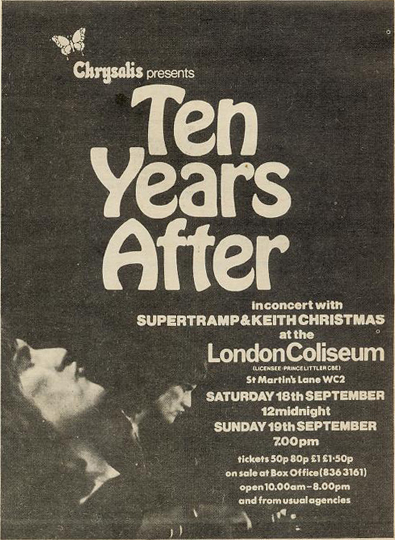
|
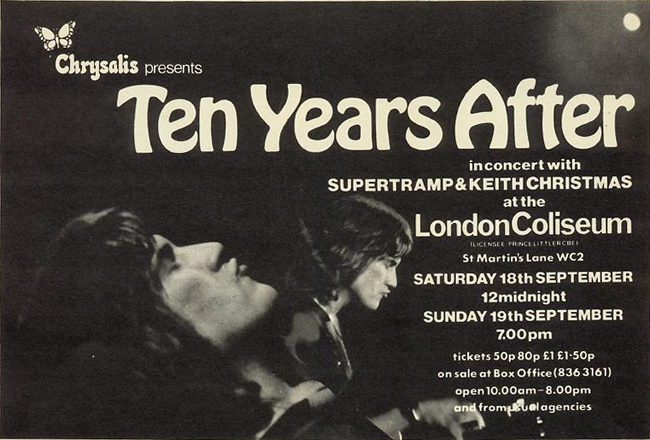
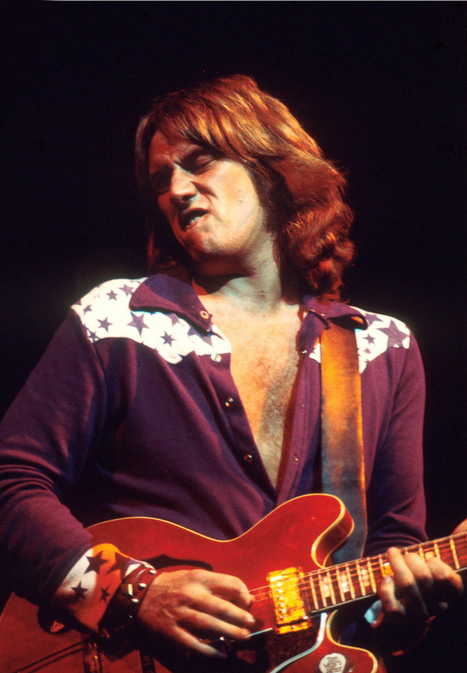
Alvin Lee at London Coliseum,
19th September 1971 - Photo by Michael Putland
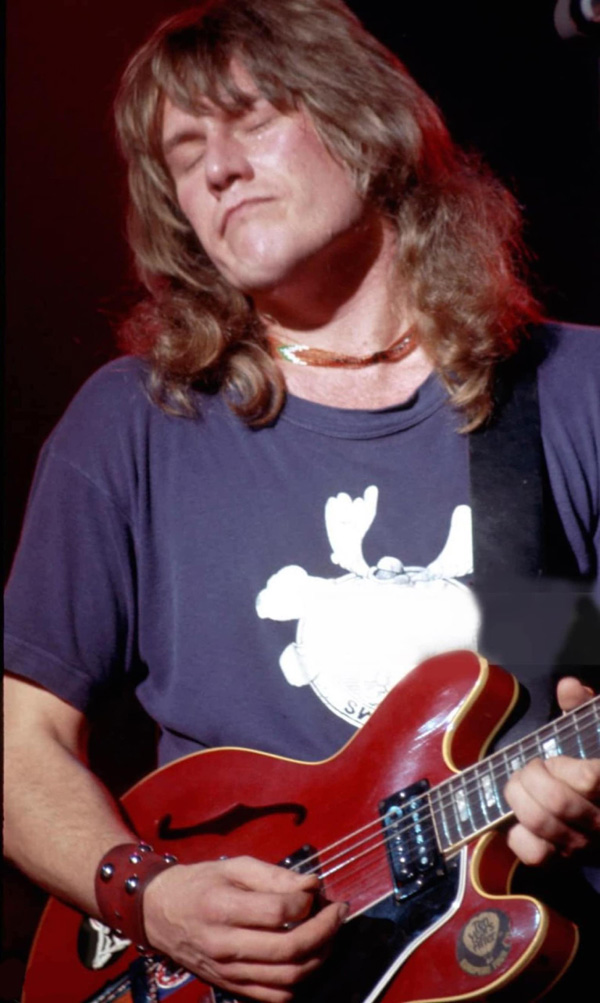
Autumn 1971 - Alvin Lee with his
second Gibson ES 335 cherry red
which he used from August 1971 til
January 1973
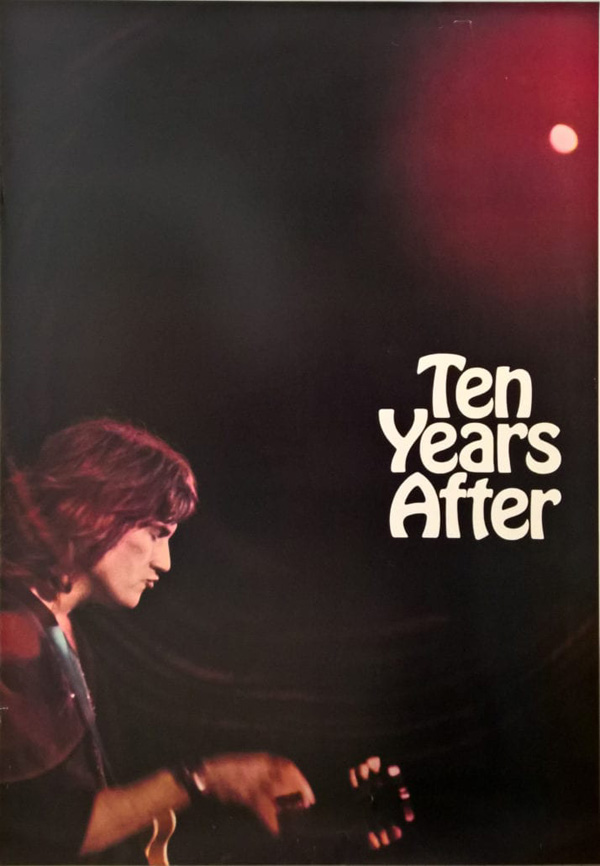
Photo and
lettering used for the concert posters from
14 September til 4
October 1971 in England
|
Original Coliseum Concert Program from 1971
KEITH CHRISTMAS
For the past few years, Keith Christmas has been
caught up in the dilemma of a personal dichotomy,
involving music and university studies. And as a
result, his musical career has tended to be
vicariously enveloped by his academic studies in
Bath.
But Keith has now passed through the educational
system and has emerged with a Bachelor
Of Science Degree in Engineering and a grim
determination to take his music to the masses.

The importance of his long apprenticeship on the
folk scene is evident, as Keith has now completely
transcended the folk circuit and found his true
niche on the rock scene. For while Keith Christmas
may be an acoustic soloist, a folk singer he most
certainly isn’t as his albums clearly illustrate.
And, in recent months he has taken full advantage of
all the opportunities thrown at him, by playing some
outstanding support gigs with “The Who” and “King
Crimson”. And in the near future, he faces the
exciting prospect of a dozen or so with “Ten Years
After”.
Keith’s third album “Pigmy” is released this month
on B & C Records (CAS 1041) and has every chance of
gaining him the recognition he deserves. Among the
back up musicians are: Ray Warleigh, Fuzzy Samuels,
Comrade Isadore, Rod Argent,
Roger Powell and Ian Whiteman. It now seems
that Keith’s days in folk clubs are over for his
bookings up until February contain no folk gigs. As
Keith says, “It just seems pointless doing folk
clubs to an audience of about 70 people when in two
nights you can play to 4,000 people, not only that,
but it’s a better gig all round”.
TEN YEARS AFTER
|
Alvin Lee
|
Guitar and Vocals |
|
Leo Lyons
|
Bass |
|
Ric Lee
|
Drums |
|
Chick Churchill
|
Organ
|
|

|

|
There have been two major British Invasions of the
American Rock Scene. The first was Beatle led and
Liverpool based, and the second was that of the
British Underground, groups who grew out of the
Blues Boom, of the late Sixties. Both produced a
handful of groups whose musical individually
captured the attention and imagination of a vast
previously untapped audience. Ten Years After were
one of the first of those groups who took part in
that second invasion, and they earned an incredible
reputation, not through a string of chart singles,
but through supercharged performances of Seventies´
rock and roll, an amalgam of their musical roots.
Alvin Lee grew up listening to jazz and blues. “Ever
since I can remember,” he says, “my folks have
played jazz and blues records around the house. When
I was ten, I was already familiar with Ralph Willis,
Lonnie Johnson, Blind Lemon Jefferson, Leadbelly
and, my favourite Big Bill Broonzy”.
Charlie Christan, a pioneer of the electric guitar
who worked with Benny Goodman, was another early
influence on Lee, who began playing with the groups
around his home town of Nottingham, which is where
he met bass player Leo Lyons, a rock and roller who
was also impressed with the work of jazzmen like
Scott La Faro, Bill Black and Ray Brown. Lee and
Lyons began playing together in 1961 and they went
to Hamburg that year as part of one of the myriad
groups working out of that German seaport, at a time
when it was the music coming out of that city’s
cellars that dictated what the rest of the music
world would ultimately follow.
Returning to England, that first group broke up
(The Jaybirds) and Lee and Lyons went back to
Nottingham where they found Ric Lee, who’d taken
lessons from their old drummer, and knew what they
were trying to achieve musically. Chick Churchill
came in on organ and Ten Years After came to London.
London’s Marquee Club, which has played a major
part in the formative years of most of the big
British groups, offered Ten Years After a residency
and from there they built up a following on the
London Club Circuit. Decca heard of the group’s
success and offered Ten Years After the rare chance
of making an album without the usual formality of a
hit single first.
In 1967, the group played the annual National Jazz
and Blues Festival, which is organised by the
Marquee. Each year has seen a new group emerge at
that festival and that year, at Windsor, Ten Years
After really came to the attention of the British
public.
Through their first album, they also came to the
attention of rock promoter Bill Graham who, having
heard the album, cabled manager Chris Wright with an
offer for Ten Years After to play the Fillmore West.
Ten Years After went to America and found an
audience as devoted as that of the Marquee, but many
times larger.
The “Underground” had become reality in America, and
Ten Years After’s reputation spread through their
appearances and their albums, which, with the new
album “A Space In Time”, now number seven in the
charts.
It’s on stage though that Ten Years After really
come across. Reporting in New York for Melody Maker,
Vicki Wickham wrote: “Ten Years After’s ultimate
break through was Woodstock 1969, and they are not
only incredibly popular, they are playing to
standing room only audiences throughout the country.
In April they shook New York’s Fillmore East. Last
week they devastated it.
“Alvin Lee, is 1971’s Mick Jagger, the audience was
turned on by him, they were mesmerised, and despite
the set going on to 4:30 a.m. in the morning, they
would have stayed forever. The fuss and commotion
they are causing is comparable to the Beatles or
Stones, partly because they are the most exciting
blues / rock band assembled, and four faultless
musicians, and partly because of the exuberance and
style of Alvin Lee.
“His fingers move like lightning, you see and hear
seven guitars, and his voice, whether shouting pure
rock and roll, moaning a white soul-blues, or just
singing, matches his playing. Drummer Ric Lee had
everyone holding their breath during a twenty five
minute solo, while he went simultaneously through
rhythms and counter rhythms, hitting and getting the
best out of everything he touches, including the
stage floor.
“Leo Lyons, has a stamina which never lets up,
whether jamming with Alvin or driving his bass
consistently throughout the set, and organist Chick
Churchill only gets mentioned after the others
because it’s been said, and he is up tempo all the
way, and totally holds his own with three other star
musicians…”
Reactions of that calibre have been reported
everywhere where Ten Years After have played through
fifteen different countries. America’s Woodstock
Festival and the subsequent film of the festival
brought Ten Years After world-wide acclaim and,
perhaps more importantly, their music continues to
gain respect . ten years on.
Supertramp Indelibly Stamped
Supertramp, one of the most exciting live bands
playing on the scene at the moment, have their
second album on release now…It captures all the
atmosphere and magic of the band live… Now hear for
yourself what real rock is all about.
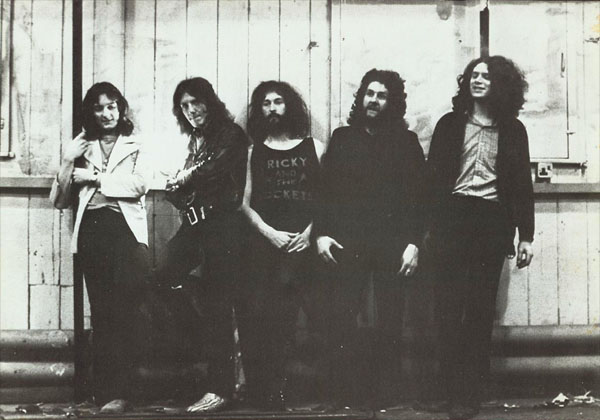
Supertramp spent one hundred hours in Olympic
Recording Studios over Easter, and the result is
“Indelibly
Stamped” their second album, issued by A & M Records
on June 25, 1971. It’s exactly a year since their
debut album “Supertramp” was released amidst high
critical acclaim, and many people wondered why the
band didn’t quickly consolidate their strong
reputation. Quite simply, there were internal
differences of opinion within the band, which took
several months to iron out. Fran Farrell replaced
Richard Palmer, who was the group’s former bassist,
Roger Hodgson became lead player. Kevin Currie
replaced Bob Miller on drums. The other group
members are Richard Davies (keyboards) and Dave
Winthrop (saxes).
In common with their first album, “Indelibly
Stamped” was produced by the group themselves.
Although they had written the songs prior to
recording, the treatment and arrangements were all
worked out in the studio.
All tracks, with the exception of “Rosie Had
Everything Planned” (Hodgson – Farrell) were penned
by Davis – Hodgson. The titles are: “Your Poppa
Don’t Mind” – “Travelled” – “I’m Coming Home” –
“Potter” – “Forever”- “Remember” – “Rosie Had
Everything Planned” – “Friend In Need” – “Times Have
Changed” – and “Aries”.
Kevin Currie comments: “I joined Supertramp two
months before we started work on the album. I had to
do three auditions (short list and things) and the
band saw 87 drummers and 93 guitarists.
“What can I say about the album…it’s right where we
all are at the moment. We’re not out to impress all
and sundry with our musical prowess and virtuosity.
We like to think people who buy the album will
listen with their heads, and not their ears, but we
don’t mind. If they get something out of it, that we
didn’t consciously put on it, then good for them. We
think and feel, both on the album and on stage. Most
of our live gigs are colleges which means we’re only
exposed to people who want to know anyway. We hope
the album will find its way into the possession of
people who wouldn’t normally associate themselves
with “groovy” college bands”.
Band Personnel:
Richard Davies – was born on July 22, 1944 in
Swindon, Wiltshire. He plays organ, piano, harmonica
and sings. He has had eight years experience and was
formerly an art student.
Roger Hodgson – was born on March 21, 1950 in
Portsmouth. He is the group’s lead guitarist and
also plays the flageolet, guitar and piano, as well
as singing. He has had five years experience and was
formerly a solo recording artists.
David
Winthrop – was born on November 27, 1948, in New
Jersey, U.S.A. He plays tenor and alto saxophones,
flute, baritone and soprano saxophones, clarinet,
trumpet, trombone, piano, as well as singing. He has
had five years experience and was formerly an art
student.
Kevin Currie – comes from Liverpool. He played in
semi-professional groups there before coming to
London to turn professional. Kevin has also backed
artists like Billie Davies and John Walker. He plays
drums.
Frank Farrell – comes from Birmingham where he
played in several local groups before coming to
London to join
Supertramp. He plays bass guitar.
|
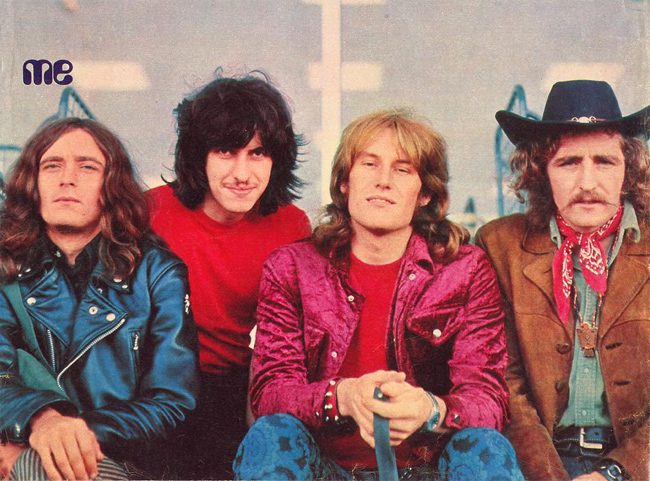


1971,
September 19 - London Coliseum Theatre, Photos:
Michael Putland
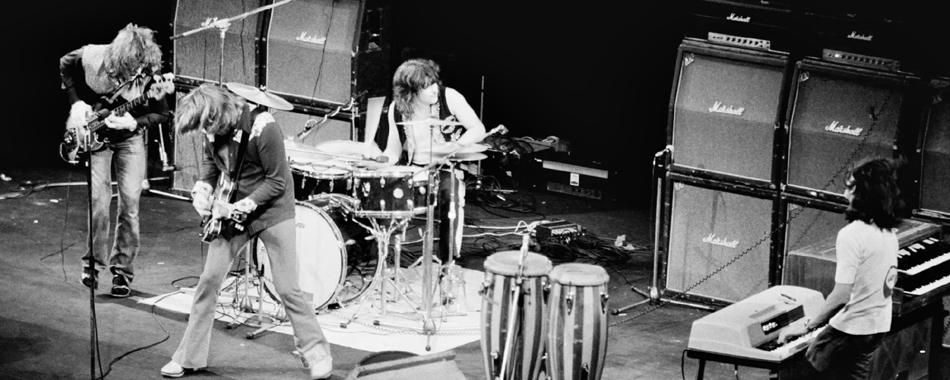
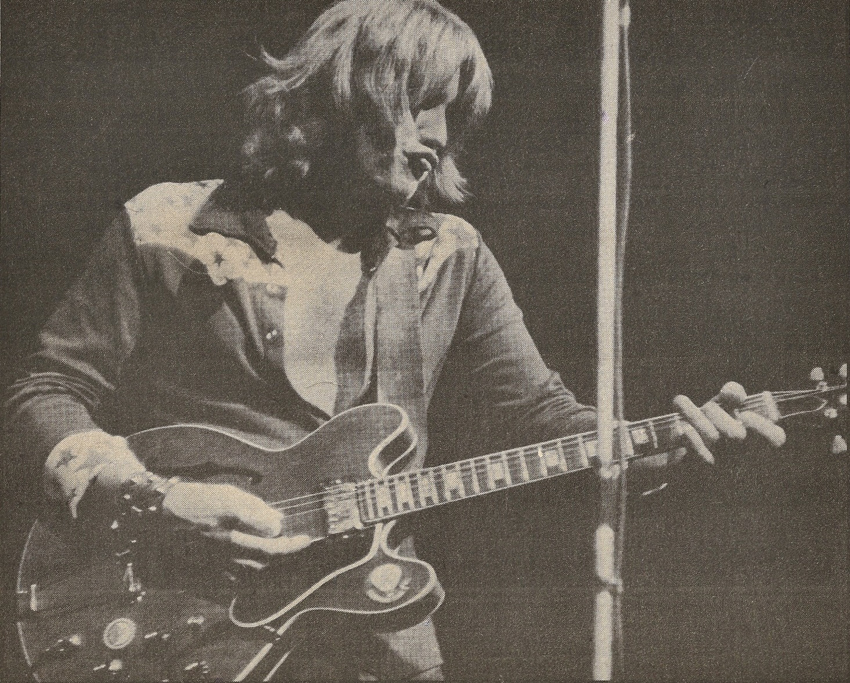
Photo: Michael Putland - published in American Songwriter
Magazine
|
September 21, 1971 –
Southampton, England.
1,000 Rock Fans Go Wild
In Soton.
Lose your inhabitions
with Ten Years After, more than 1,000 rock fans went
wild in Southampton Guildhall last night at the climax
of the the groups performance.
As the group roared into
their famous Woodstock Festival Number I’m Going Home,
the fans leapt out of their seats, and started dancing
in the aisles. Others jumped on top of their seats
clapping and stamping their feet. At the end of this
steamroller of a number, nearley everyone present
stood at attention, giving the group the peace sign
and then called them back for an encore. Warmed by the
audience response, Ten Years After - obliged with a
rousing version of "Sweet Little Sixteen," a number
they have adopted from Chuck Berry.
So popular are this
british group, that all the seats were full well
before the concert started, and many ticket holders
including myself, had to sit in the asile.
Ten Years After play
some excellent blues – rock. One criticism – they do
tend to be a bit riffy at times, but I suppose, you do
get blasé sometimes after you have seen as many rock
concerts as I have.
Article Written By - B.D.
|
|
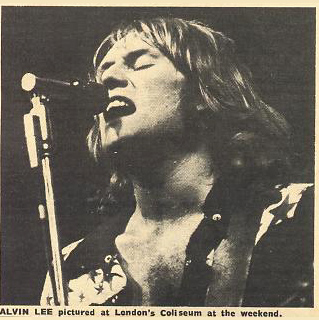
New Musical
Express September 25, 1971

Ten Years worth the wait:
After a long absence, Ten Years After returned
to London in styles last weekend when they
appeared for two nights at the London
Coliseum. It was a good venue for them since
they were determined to make a London
appearance during their British tour and had
to hold it off for a while (since their Royal
Albert Hall ban) until they found the right
hall.
Comfortable surroundings, central location,
fine acoustics all contributed to making the
Coliseum such a place, and it’s a wonder more
Rock acts don’t use it.
Keith Christmas received a deservedly warm
reception and despite his apprehension and
nervousness about appearing before a
predominantly Ten Years After audience. He was
called back for an encore which due to the
pressure of time, he couldn’t do. Little quips
like, “This is a 16th century folk
song written by me,” thrown out by a little
guy with an acoustic guitar in the centre of a
vast stage obviously appealed to the sense of
humour of the crowd.
“Acid Queen,” his tongue-in-cheek folk number
drew laughter and added to the charisma of the
evening.
Supertramp next and Ric Davies, Kevin Currie,
Roger Hodgson, Frank Farrell and Dave Winthrop
had complete command of the audience.
Excellent musicians with a good line in spiel,
a strong melodic content to their compositions
and a driving rock beat, they proved that
they’re soon to emerge as a top line outfit.
Ten Years After of course, created a riot and
the capacity crowd of 2,500 were on their feet
at the end of “I’m Going Home” and they
brought Alvin Lee, Chick Churchill, Ric Lee
and Leo Lyons back for three encores of the
supercharged rock
`n´ roll that has earned them a
reputation of being one of the finest rock
bands in the world. Their music ranges through
the whole spectrum of contemporary rock: it’s
a fusion of jazz, blues, rock and even the
classics. Alvin demonstrated it all. His “Slow
Blues In C” proves he is a great blues
guitarist and Chick Churchill added fine
touches on electric piano. Churchill is coming
more into his own now, both on electric piano
and organ, and his keyboard work fills out
what is one of the best rhythm sections in
rock.
Leo Lyons on bass and Ric Lee on drums lay
down an incredible foundation for Alvin to
work from. Ten Years After combined both the
old and the new. Old favourites like “No
Title” and Ric’s drum solo “Hobbit,””
which earned a standing ovation, but
nothing like the response for “I’m Going
Home”.
Their encores were “Baby Won’t You Let Me Rock and
Roll You” from their new album and a couple of
high tension rockers.
By Sean Sowry
|
|
|
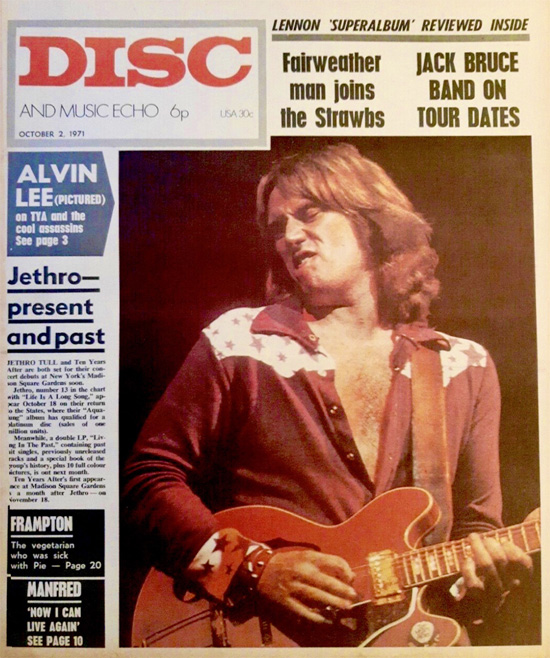
October 2, 1971 –
Disc and Music Echo Magazine


Ten Years
After seem to come in for criticism whatever they
do. They spend too much time in America…and then
when they do play over here, the cool critics say
they aren’t much good.
It’s enough
to make a band split up, but Ten Years After take it
in their stride, although Alvin Lee does get a bit
mystified by the attitude of the Pop-Press. “We’ve
really enjoyed this current British Tour. The
audiences here now listen much more attentively, the
same as they do in the States. We’ve been putting
more stress on the first part of our act, but we
still get the odd freak judging us only on the rock
`n´ roll we do at the end, and saying we’re a load
of rubbish. “I can take criticism, but it always
seems to be, “the audience liked them, but I the
reporter, was the only one who really knew how bad
they were.” “The thing is, that we like to play rock
`n` roll at the end of a show, if we have any energy
left, we like to put it all into the last number,
then we feel we’ve done a good night’s graft.” Alvin
says, that many of their problems have stemmed from
“Woodstock” and “I’m Going Home.” On their new
album, “A Space In Time,” they try to show, “some
musical maturity.” After nearly five years together,
they ought to be a better band. It’s been over a
year since Ten Years After appeared in Britain, and
Alvin is genuinely surprised at the change in
audiences, of audiences in the States, he says; “the
latest thing is that people who buy the cheapest
tickets at the back, rush to the front when we go
on, so that the people who buy the most expensive
tickets can’t see.

We’re seriously thinking of making tickets all one
price over there. “But in Britain, audiences are so
cool. “they listen to the intense things and enjoy
themselves at the end with the rock `n´ roll.” The
record album is released on October 15th,
and he says, it’s the first one they’ve tried to
produce systematically. “We’ve always played on
albums the same as we do on stage, but this time we
cleaned things up and spent more time on it.”
They’ve been playing three numbers from the album on
the British tour: “One Of These Days”, “Hard
Monkeys” and the first track on side two, “Once
There Was A Time.” “I’m never really pleased with
albums, because every time you play them you hear
different faults, but this is the nearest thing to
doing one properly. We spent a lot of time tidying
up, although really the more you strive to make
something perfect, the more you are contriving.
Really, an album is just a
documentary of what you happen to be doing at the
time.” Alvin says, the material he wrote for it is
more milder than on previous albums, because he’s
moved out of London, and into a much milder
environment. “Your environment definitely plays a
big part in what you do. We had three months off
earlier this year, and I didn’t even see an electric
guitar all that time. I wrote lots of things on
acoustic. “That was the first holiday we have had in
four years, and we stayed “off” until we were so
bored, we really wanted to get back to playing.”
That was the time when all the “split” rumours
started flying around. “And there never was any
question of a split.
“Nobody
dominates in our band, although most people think I
do. I’m the lead singer and lead guitarist and I try
to bring out what’s in the others, but Ric, Leo and
Chick bring out things in me. None of us are selfish
musicians. “Five years ago we went through the
hassles of who was going on stage first - now we’re
just interested in making music. “We’ve been
described as virtuoso musicians and all sorts of
things like that. I’d be very pleased to think we
were, but even if we were, I wouldn’t say it. “A lot
of people misunderstand Chick, because he doesn’t do
super solos. He’s there to blend it all together,
even though he’s the more advanced technically than
the rest of us. If he wanted to do twenty minute
erotic solos, jumping up and down the keyboards, he
could. Ten Years After return to the States on
November 5th but they hope to play
Britain again very soon, hopefully early next year.
“Perhaps we have spent too much time over there, but
you can tour Britain in a week and a half, It’s so
vast in America, that you need to do six tours to
get round everywhere.” November will be their 12th,
so that’s only like playing everywhere twice. Alvin
won’t accept that Ten Years After have become too
successful for Britain. “We’ve never had a gold
album and we’ve never appeared on Top Of The Pops,
but we get a lot more criticism than the groups who
do!
By
Roy Shipston
|

|
Sounds Magazine
October 2, 1971
|
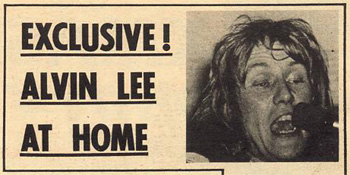 |
|
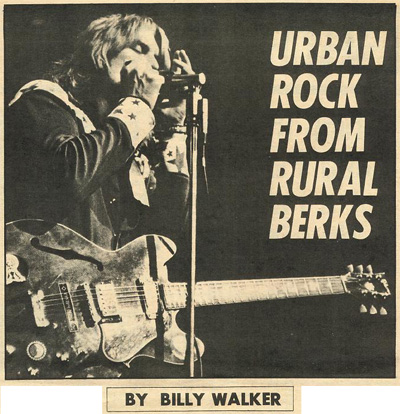
|
Thirty Miles
outside of London, in the rural tranquillity of
pastoral Berkshire lives Alvin Lee, one of Britain’s
most recognisable faces in the urban rock business.
Mr. Lee, guitarist and self-effacing figurehead of Ten
Years After, is perfectly aware of his star status,
despite efforts to minimise the aura that accompanies
it, and is acutely conscious of the responsibility
that a man in his position and of his particular
calling has today.
In his
rambling country home, an acquisition once the
exclusive domain of novelist, artists and playwrights
but now very firmly in the hands of the rock elite.
Alvin sits relaxed in a cowboy shirt, faded Levis and
bright red clogs, talking about his new found
enthusiasm and sense of well-being, that his escape to
the country has brought him and his reactions to
criticism that have been levelled against Ten Years
After on their current British tour.
|
Ride:
Despite the
band’s undoubted public acceptance, Alvin has not yet
found he is able to ride criticism, in fact at times
he feels more vulnerable: “What really gets to you, is
when something isn’t represented, as I feel it really
was. I do ride over some of them, but I don’t get
involved like John Lennon or Paul McCartney who write
to papers with answer back letters, I’d never do that.
“Sometimes, you find it’s a bit depressing: You do a
concert which you thought was good, and you’re quite
pleased with it because everything went well, but then
somebody will write that it was “all right”. But I
don’t believe all I read in the papers, and I’m sure
nobody else does. “I read in one of the musical papers
last week, two reviews of the same concert, one was
good and one was bad, and that’s about it”. But he did
think that there could be a little more to bad reviews
than lack of understanding: “I know some of the
politics behind reporting. A friend of mine in the
States, John Mossman said that any reporter who wants
to make a name for himself, will knock established
names. Therefore, people will write letters to the
paper and the editor will notice that he is getting
read”.
Rave
Up:
Alvin thought
that it was a bit unfortunate and that music should
really be a bit above all that, saying that in the
London Coliseum reviews and papers had, “belittled
everything” and didn’t really mention “what was
important”. Another thought was that perhaps
“Woodstock” had not helped in this respect. “After
`Going Home´ in the film of “Woodstock”
everybody associated Ten Years After with “Going Home”
which is all very well but what we wanted to do was
bring out what else we do as well. We always end up
with a rock and roll rave up, because it’s a nice way
to end a gig, but we also play a lot of serious music
as well, but the papers just mentioned the rock and
roll because everybody stood up for the last three
numbers”.
Diet:
Critics,
whether of films, plays or musical concerts, see an
awful lot of the same diet, and Alvin was prepared to
make this concession: “They’ve got a set idea of what
we’re going to do and it’s difficult to blow
somebody’s mind if they’ve seen you a few times. We’re
not a sensational group, we don’t blow people’s minds
on purpose, we just play the music as it is.
“If everybody
has seen it and gets bored with it, there’s nothing we
can do. We won’t change it because that’s the case, we
just keep on playing to the people who want to hear
it. “That brought up the subject of Ten Years After’s
progression, a thing that Alvin had said he didn’t
like pushing. “It’s very easy to force it, to think
what you should be doing. A lot of bands progress,
because they think the audience wants them to do it,
but often you get out of touch with everything that
you are actually doing. We try and bring out what’s
there”.
On stage Ten
Years After are fairly straight, despite Alvin looking
pretty sharp in an all red outfit, and with red
electric guitar, etc – there aren’t the stage antics
that many bands employ.
Did he think
that they lack anything in the theatrics on stage? “I
don’t think we lack anything anymore than I think the
concerts lack anything. In England it’s been great.
I’ve really been happy because the people, apart from
the last three numbers, where we invite them to get up
and dance, have been really listening. You can hear a
pin drop during some of the more progressive things
we’re into, it makes you play better when everyone is
listening”.
Speed:
Inevitably,
Alvin’s guitar style, particularly has speed at times,
has come in for a lot of argument, for and against,
but he refuses to be drawn into such arguments,
preferring not to stoke the fires that he feels that
he feels are quite irrelevant and which he dismisses
as “schoolboy talk”. He says that these sort arguments
tend to lay false emphasis on what the people think
the musicians are like-creatures an image that isn’t
at all like-like. “We’re very seriously involved in
what we do and try and concentrate on improving it and
not having “groovy” images. We are what we are, and
the only way I think we have suffered by that, is that
people really don’t know us as people. It’s kind of
worked the other way. “I’ve always thought that if I
don’t hype and bullshit, and don’t go flashing my face
around, doing the old Cadillac bit, it would be cool,
and it is cool obviously, but people don’t pick up on
that. They think you’re doing an out-of-the-way Greta
Garbo, or something, and that’s come back on us a
little”. In very much the same way as people from
their individual ideas of what they want their artists
to be like, they can be pretty undiscerning when it
comes to live performances, willing to put up with
less than one hundred percent effort or mediocre
concerts: “We’ve had what we considered bad gigs, and
we’ve been a little disgusted with ourselves where
we’ve gone down really well, but our sole purpose
isn’t just going down well at all. “If the band don’t
think they’ve done well themselves, it makes you feel
hollow and that there’s no reality in what you’re
doing. No one’s into it as much as the musicians
themselves, we’ve never played the same thing twice on
stage, there has always been something a little
different, but I don’t suppose anyone’s noticed”.
The
understanding that Ten Years After have on stage isn’t
something that has come overnight. The band has been
together five years, and Alvin and bassist Leo Lyons
have been playing as a teem for eleven years. This
shows in their sort of “sixth sense” during the
protracted jams they work on, but the obvious equality
of the individual members, despite the spotlight
inevitably falling on vocalist / guitarist Alvin Lee,
was dented a bit recently, when a reviewer thought
some of the band members might not be up to a certain
musical level.
“It’s really
sad,” said Alvin. “I don’t really see what is the
point of taking one person out and comparing him to
the others, it’s a British fad, it doesn’t happen so
much in other places. Chick Churchill for instance, is
probably the least spoken about, or written about
musically, but he is probably the best musician in the
band. It doesn’t come over because he’s not the most
forward, he doesn’t play long solos, or go shrieking
up and down. “He’s been playing classical piano since
he was five years old, and he can bring off a quick
Tchaikovsky and blow my mind. He can read and write
music perfectly, which I can’t, all I’ve done is
develop my own personal style, like a way of musical
thinking. I don’t judge myself technically or question
what I do. I just do it”. The physical strain and
mental pressures on musicians, particularly those at
Ten Years After’s level, where the need to be as
near-perfect as possible is of prime importance, is
often played down. Gruelling eleven week tours of the
States and all that goes with them, creates the need
for something else away from music, an escapism if you
like.
Off the road
it’s hard to imagine their respective forms of
relaxation. People tend just to think of Alvin for
instance, as a handsome dude, up on stage playing
lightning licks on his Gibson, and sending the ladies
into fainting fits, but his particular crouch and fits
of flying hair, is another very relaxed guy, who is
very much into horses.
Fresh:
“My
“alter-ego,” admits Alvin, “is photography. I got more
of a thrill about getting a couple of pages in
“Armature Photographer” than our albums getting into
the charts”. It’s all down to relaxation in one form
or another, and it’s helped Ten Years After iron out a
few wrinkles and smooth off a few ragged edges when
they returned from their recent lay off, to face the
new album with a fresh outlook. Alvin says, that
moving to the house in the country helped the album
called: “A Space In Time” considerably, it helped him
think and also gave his song writing a freer rein.
“It’s the first time I’ve had more songs than we
needed, we got about seventeen tracks down. “We spent
much more time producing the album, our impression
before had always been, “we’ll play it in the studio,
and how it sounds is how we are and that’s the truth,”
which is all very well, but the ragged edges were
getting more ragged, and it got to the stage where we
thought, we could go and blast an album off, this time
we spent more time rounding the edges off”. One of the
best tracks on the album is called:
“Hard
Monkeys,” which makes a very positive stand against
hard drugs and it was intended to do just that. “ In
the States particularly,” stated Alvin, on the subject
of drug taking, “there are twelve year old kids taking
heroin because of the romanticised part of it. Some of
the kids, and I don’t refer to audiences as kids, but
there are some in America doing it because they think
Jimi Hendrix and Janis Joplin’s deaths were romantic
and a good way to go.
Drugs:
“People
associate all bands with hard drugs, and they
naturally think everybody is on it, so I thought I
just wanted to state that I wasn’t”. But Alvin was
prepared to take it further by not wearing T-shirts
proclaiming the use of drugs: “I don’t think of myself
as a rock star, but there are a few who went to see
the movie “Woodstock” who think we’re a “real groove”
as it were, and you’ve got to be aware that there are
a few you could be a very strong influence on them”.
Even rock and rollers like Alvin Lee have to face the
fact, that advancing years might see their hair
greying, fitted shirts and tight trousers bulging, and
the on-stage exertion bringing gasps for breath, so
what happens at thirty-five or forty years of age for
him?
Grown:
“I used to think when I was eighteen, when I blew all
my lessons out to play the guitar, what I’d be doing
when I was twenty-one. I’d be a fully grown man then,
not a young lad with a guitar, but the whole thing has
matured now anyway, and it will phase in one direction
or another. I can’t say which way it will go, but the
opportunity will arise for me to do different things.
“I don’t think that at any point in my life, I’m going
to have to say “I’m too old to play guitar, so I’ll
have to do something else!” That will certainly please
Ten Years After / Alvin Lee devotees and until then we
can expect more urban rock to germinate in rural
Berkshire, and if that isn’t a contradiction in terms,
I don’t know what is.
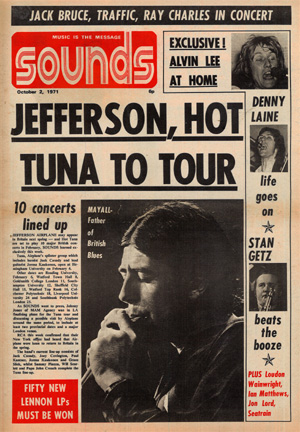
|

Ten Years After - Live On Stage -
Concert and Date Unknown
But Love This Beautiful
Black and White Photo
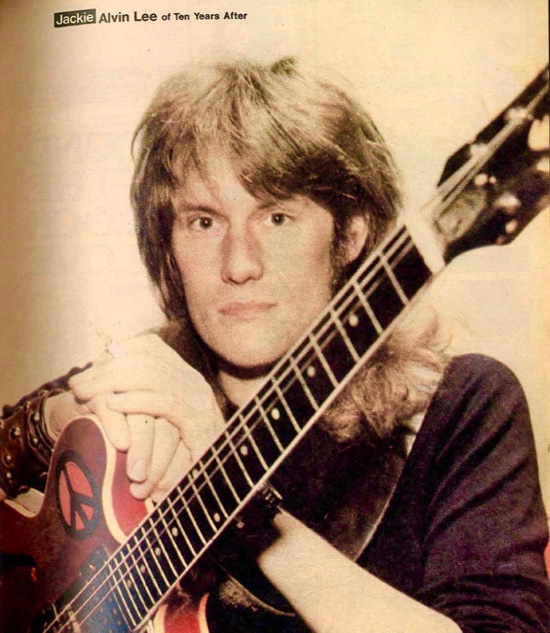
Jackie Magazine,
No. 407, England - October 1971
|
A Space In
Time-was recorded at Olympic Studios - London, England and
released in August 1971
The Rolling Stone Magazine Review, from
October 14, 1971
“The original material and arrangements are terribly lame…As
the Romans used to say…let the buyer beware…”
In another article a little more positive review:
A Space In Time was Ten Years After’s biggest commercial
success. The reasons are pretty obvious; Alvin Lee’s song
writing had improved markedly and there was far more stylistic
variety than on their previous albums.
The big hit here was “I’d Love To Change The World,” with its
catchy acoustic guitar hook and immortal opening line,
“Everywhere is Freaks and Harries.” Other high points include:
“Baby Won’t You Let Me Rock ‘n’ Roll You,” the bands first
stab at a Stones-style raunch (complete with a riff from Led
Zeppelin); the country-ish romp “Once There Was A Time”; and
the gently folky and surprisingly self-deprecating “Over The
Hill,” which features strings, a move that would have been
unthinkable for this band a year or two earlier.

|
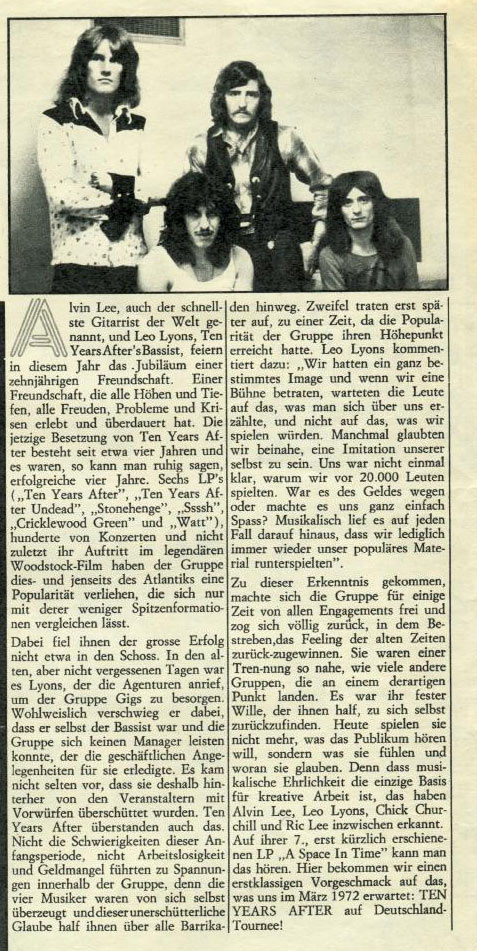
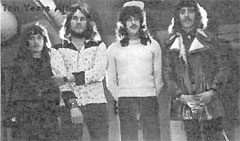
The original size of the photo above, is
really just half the size of a match-book cover.
With the help of photo-shop, we
were able to save this, and not let it go to waste in the
dust-bin.
|
Guitar Player Magazine – October 1971
A Magazine For Professional and
Amateur Guitarist
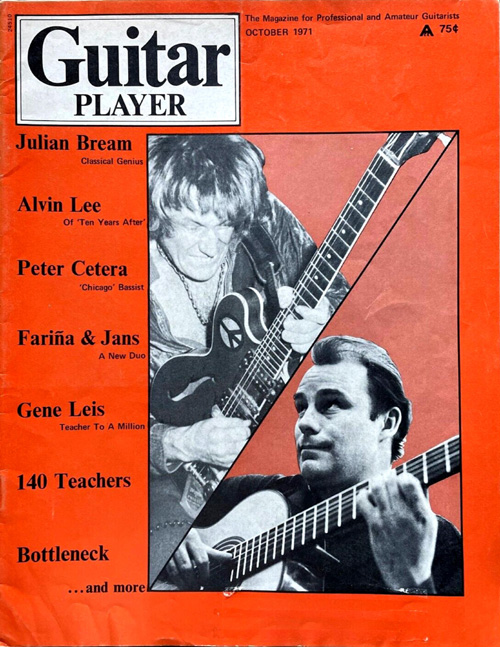
And into the mystical music machine were fed the
following: white-covered rock and roll, black blues,
Rhythm and Blues, early jazz and old licks. The
reply: cannot assure success / slight loss of
musical integrity / musical form and character must
be raw, dense and tortured / cannot compute monetary
value of Woodstock movie exposure / throbbing beat
and super speed required / cross fingers and wait.
By Michael Brooks
It is easy foe fellow musicians to categorize Alvin
Lee as a “Hot Licks Copy Kid,” or accuse him of
sacrificing musicianship for showmanship, but seldom
is his perspective sought for the rebuttal. We spoke
with Alvin during a Ten Years After tour of the
States, to learn his side of the story.
Alvin is not unusual as far as the wide and varied
realm of guitarist backgrounds goes. He grew up in a
musical family, in the small English town of
Nottingham. His parents collected 78-rpm Jazz Discs
from the 1930’s and 1940’s and his mother played
tenor guitar. His brother took up the clarinet which
induced Alvin to make a similar attempt. After
playing woodwind for a year, Alvin found that the
lessons were not all in vain since the instrument
introduced him to the genius Charlie Christian.
Alvin soon traded his clarinet for a guitar and
began four months of chord lessons.
About this time, in another part of the world, a mad
dog musical revolutionary entered the scene, Bill
Haley and his rock-around the clock Comets. “Bill
Haley was the first guitarist I had ever really
listened to,” Lee recalls. Then other guitarist
followed in a seemingly endless stream: Fran Beechy,
Elvis Presley, Scotty Moore, Tal Farlow, Barney
Kessel, Tod Dockstader, Joe Pass and of course, the
European Gypsy himself
Django Reinhardt. About Django, Alvin says, “I was
amazed at his playing, but I really couldn’t relate
to him. I really just got into his chording which
tore me up.”
Young Alvin spent many hours learning the
fingerboard. He used to take just a fingerboard to
school each day, and while the teacher expounded
facts of disinterest to the aspiring guitarist,
Alvin would be working his fingers on it concealed
under his desk.
So Alvin’s guitar started as a childhood hobby, with
no premonition of an occupational aftermath, but at
the age of sixteen the hobby became an obsession
when he left school and needed a way to earn a
living. His listening progressed naturally from the
disk of Merle Travis, which led him into Chet
Atkins, and when Chet started his classical trip, it
steered Alvin into Juan Serrano. Today, (1971) he
still enjoys playing Chet’s material, “but I’ve
allowed my own style to interpret what I feel Chet
is saying.”
Around 1964 Lee teamed up with Leo Lyons, a fellow
home-towner, on bass and produced an electric trio
with the addition of a drummer. The group did
small-time for a few years and then went on to
Hamburg, Germany, gaining pockets of fans wherever
they went. While the group was going, Alvin and Leo
both worked studios for existence, and then in 1967
the duo met with Ric Lee (No relation to Alvin) on
drums and Chick Churchill on organ – and became “Ten
Years After”.
They realized the English environment was not all
that receptive to new bands, so they began endless
treks across the sea to tour the United States.
Today, the group performs very tightly on stage with
occasional improvisatory interims, a far cry from
the raunchy rock group in Hamburg.
Alvin is apparently disappointed with much of
today’s audiences. Ten Years After, previously a
solid underground group, has fallen from that
plateau onto the fields of commercialism. Alvin
feels this is not the group’s fault, but that of the
masses who swarm to see the man from the “Teenage
American Dream,” Woodstock, and his own ambition to
please his audiences.
“We were underground, but now the whole scene has
changed and we’re pop stars. Sometimes, I feel I can
get away with playing just feedback,” Alvin sadly
admits. Along the way, he did listen quite heavily
to the sounds of other groups, and in a sense did
copy some of their licks, but says, “I tried to keep
them separate from my own music”. He often had
misgivings about rudimental music and consciously
sought to avoid playing others solos. Alvin sees his
playing much like one poet reading another’s
material. The poet’s style still remains legitimate
if he integrates his feelings with the original
author’s intentions.
Among musicians, one of the main criticisms levelled
at Alvin’s playing ability is his “uncontrolled”
speed, especially in the phrasing of his licks. He
explains, “I’m not conscious of the speed. It’s a
feeling, an emotion that my fingers lodge upon the
neck and I can get fast, but it’s not my motive. My
motive is displaying a voice through the
fingerboard.”
To achieve his speed, Alvin used the mind-boggling
method of repetition until each lick became more of
a reflex than a thought. There is one point though,
where his speed is a conscious thought, and that is
when Alvin is producing a musical crescendo. “Then,”
he says, “my style is more neurotic and is basically
a fingerboard pattern from rote memory, which found
its way into an explanation of how I feel the music
should be”.
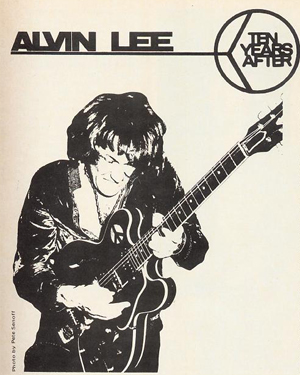 Alvin
maintained a good balance of income and integrity as
he grew in popularity. He always made it a point to
keep his music valid. “If things got to commercial
for me,” he says, “I just wouldn’t show up. I found
that I had reached a point where, where if I tried
to reach too hard, I would just become a caricature
of myself, so now I am playing to myself”. Alvin
maintained a good balance of income and integrity as
he grew in popularity. He always made it a point to
keep his music valid. “If things got to commercial
for me,” he says, “I just wouldn’t show up. I found
that I had reached a point where, where if I tried
to reach too hard, I would just become a caricature
of myself, so now I am playing to myself”.
On stage Alvin Lee’s equipment is not radical for
the sound he is attempting to achieve. He uses a
very old Gibson 335 with a few minor changes. He has
taken off the pickup covers, which he feels “brings
out the trebles and the basses,” and he has inserted
a Fender Stratocaster pickup wired to the back
pickup closest to the bridge. He prefers reasonably
high action on his instrument, which is strung with
Fender thins on the top three strings and Gibson
Sonomatics on the bottom. This type of string set-up
affords him a heavy rhythm when he wants it and yet
he is still able to hit the high licks with room for
bending the notes.
With his right hand, he uses a very heavy flat pick,
the three-cornered type, for that special shuffling
effect. This pick also allows him to change corners
when one tip breaks or wears down.
He uses a 100 watt Marshall amp, with 16 – 12”
speakers in four cabinets, the reason being that he
likes amplifier distortion, not speaker distortion.
With the powerful Marshall and many speakers he can
even get harmonic distortion. Amplifier volume
settings on stage usually run from three-quarters to
full to avoid distortion “dry-up” or decay. Alvin
doesn’t use pedals of any sort, because he feels
they only clutter up the stage.
The young Nottinghamite has become synonymous with
the high speed attack. Sometimes it’s regulated and
sometimes it’s not. “It all comes in different
categories. It can get to the point where I don’t
have control over what I am playing. I sometimes
relate to other guitarist, using my own thing. I try
to let it go on a natural progression, but basically
it depends on the audience. Sometimes I just press
notes to test or feel them out. Sometimes I can
point a guitar just right towards my amp and get
full harmonics. I like to contrast the high with the
low as far as playing up and down the fingerboard.
The basic style develops from me trying to please
myself. When I get bored with what I am playing, I
push on”.
A walking library of well-executed licks, Alvin has
instant recall for seemingly any music he has heard
or done. While he is restless enough to push on to
different types of music, admittedly, he will never
leave “good old rock and roll”. On stage the
fanatical electricity is thought of as a “work-out,”
he says, “and I never end the gig until I can sing
no more”.
Like many rock guitarist, Alvin is getting into
acoustical music for his own enjoyment, recently
purchasing a Martin D-35, and is working through
open tuning of the Mississippi derivative. He plays
a stylistically unique version of Steve Stills
“Black Queen” done in open D (D,A,D,D,A,D) and is
getting into open G (G,B,D,G,B,D) and a
dissonant-sounding open A (A,A,E,A,Db,E) – “When I’m
playing for myself, I like bass string ringing in
the key I am playing in,” comments Alvin.
Not uncommon in the realm of so-called stardom, Lee
occasionally questions his basic musical existence.
“Sometimes I get very little self-encouragement ,”
he muses. “At one time I could relate to what I was
doing. Now, I can’t judge if I’m doing anything very
valid, I can’t judge myself. It got to a ridiculous
point, that when we were rehearsing, we would do
regular numbers instead of working out new tunes. We
work jams and remember certain phrases, but it gets
to a point where you are constantly doing old tricks
on stage, with old licks and riffs.
You’ve got to get bored with that before you’ll ever
end up doing something a little different. Like a
show we did in Vancouver: the press later said it
was something like:
“several constipated musicians and Alvin Lee is one
of them”. I don’t know, maybe he’s right”.
Alvin Lee is not entirely a picture on an album
cover, nor is he merely a sound in a groove; he is a
man who is sensitive to the criticisms levelled at
him and is not totally sure that some of the
critiques are not valid. One thing for sure though,
is his rejection of himself as a pop star, even
though its remedy means a breach of contract. His
thoughts are open, “I think it’s a kind of
masochistic thing in a way, playing with the things
in vogue. It’s grown on me, but I like to think of
myself as a guitarist, and not as a pop star”.
He appears perplexed over the obvious similarity
between “Grand Funk Railroad” and “Ten Years After”.
“Grand Funk formed a cloud in my mind,” he claims,
“and the guitarist plays similar things to what I
play, but he doesn’t have much control”. And yet
these same comments often shadow him.
Alvin’s objective is learning and living, and in
that he finds consolation and creation. He realizes
that “learning becomes slower as one progresses, but
each new thing becomes more and more beautiful”. Even
though the public sees Alvin Lee as firmly established
in his style, he is continually evolving towards a
greater maturity and perhaps someday full and just
commendation will be given this artist within his own
perspective.
|
|
October
14, 1971
- Rolling Stone Magazine
Ten Years After – A Space In Time –
Album Review:
Like a hamster
running on a treadmill, Ten Years After is expending
energy without moving.
“A Space In
Time,” is the group’s first album for Columbia
Records, but it re-hashes most of the material on the
last four Ten Year After releases. There are a couple
of Alvin Lee guitar specials, several low key attempts
at relevant social commentary, and a lot of
underdeveloped and unsuccessful music. The record in
an improvement over the disastrous “Watt” album, but
hardly a sufficient one. The original material and
arrangements are terribly lame. Vocal melodies and
guitar lines are virtually indistinguishable from one
song to the next, and few arrangements highlight
anything besides Alvin Lee, and his two, three or four
guitar parts.
Chick
Churchill’s potential as an additional soloist, for
example, is stupidly wasted, by having him play only
rhythm accompaniment on piano and organ, behind
Alvin’s numerous leads.
Although
bassist Leo Lyons and drummer Ric Lee provide the band
with a foundation that is both workable and firm. Ten
Years After does not use this rhythmic support to the
best possible advantage. There are some worth-while
exceptions however:
“One Of These
Days” is a compelling track with good all-round
instrumentation, even if it does drag on a bit. “Hard
Monkeys” and “I’d Love To Change The World” contain
intriguing guitar riffs, but nothing much else of any
distinction. The best piece on this album is a Chuck
Berry white-wash called: “Baby Won’t You Let Me Rock
and Roll You”. Ten Years After is quite adept at
playing this quasi Berry stuff, but I wish they hadn’t
tacked on many banal sound effects to spruce the song
up.
Alvin Lee’s
lyrics have always served as merely adequate vocal
companions to his instrumental pyrotechnics, but the
words on this album border on the senseless and inane.
When Alvin sings, “got no streetcar named desire / and
I’ll never light her fire” in “Hard Monkeys,” you know
he doesn’t know what he’s talking about, and a poet
he’s not; just listen to his attempt at a tactful
metaphor in the horrendous “Over The Hill,” – “like a
cripple and his crutch / I have learned a bit too much
/ seems that doubt (?) should never touch again”.
This song,
incidentally, features a grating string quartet
arrangement behind Alvin’s singing and easily rates as
the group’s worst studio track.
Fans of Ten
Years After will undoubtedly receive “A Space In Time”
with wide open arms, but others may find the weak
material and electronic Léger de main too much to
bear.
Review by –
John Koegel
|
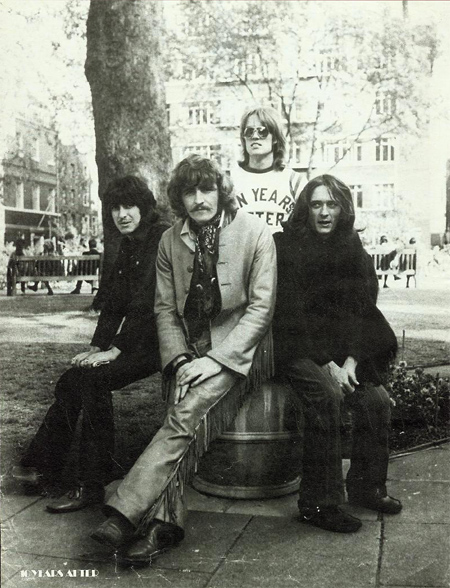

|
VERONICA - October
16, 1971
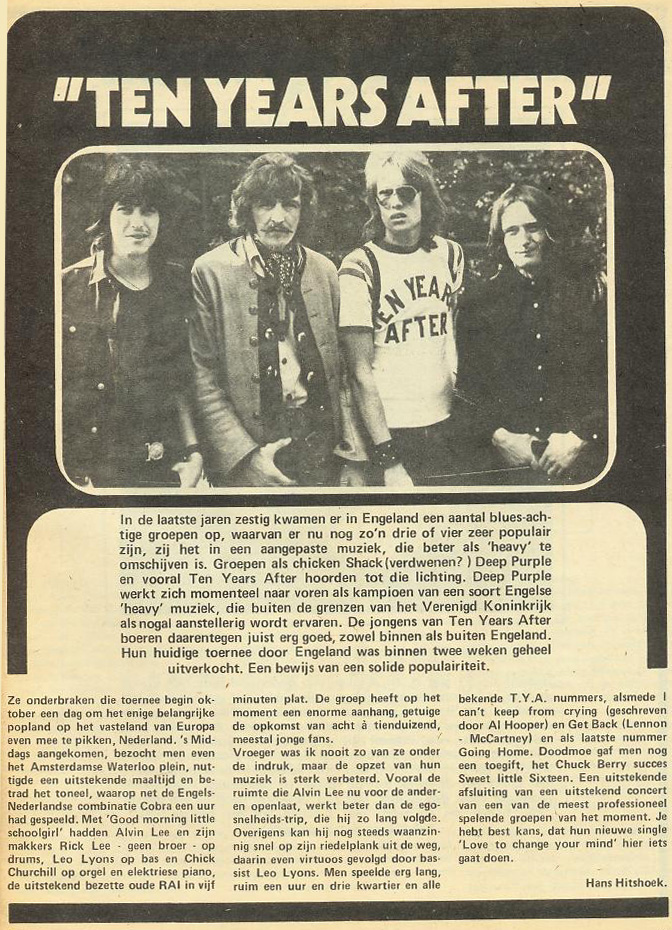

|
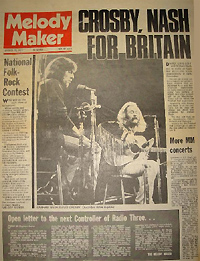 October
23, 1971 - Melody Maker October
23, 1971 - Melody Maker
Ten Years After - “A Space In Time” (Chrysalis)
Yes folks, Mr Alvin Lee and his rock and roll band pushing
out the most relevant thing they’ve done to date.
This album’s got the guitar and vocals of a bitchy old
lady: out for trouble, and finding it.
Lee is at his meanest, with guitar and vocals that don’t
rely on frills nor finery, just quick fingers and a
poisonous,
Venemous tongue. It opens with “One Of These Days,” a
rising, cosmic noise that lashes into a furious half-bop,
half-boogie, taking in about every facet of Lee’s hard
shifting guitar. That all melts down into “Here They Come”
soft and acoustic, but with an underlying riff of menace.
“I’d Love To Change The World,” is another in the more
complex TYA book, with Lee adopting an almost angelic look
on life, but a quick “oh yeh!” rattles it onwards.
Then there’s
“Over The Hill” the most beautiful track on the
album, tumbling with melody and TYA is the
Last band you’d expect that from. Yeh, strings, lots
of them, and it’s as commercial as you’d ever get.
With the effect of somebody finding the rock and
roll channel on the radio, we get the real 50’s
influenced
Band, “Baby Let Me Rock and Roll You,”
barrel–rolling piano and Alvin on long metallic runs
with echoed,
gutsy vocals. Short, sweet, and just dandy.
Down home blues, is here too with things like “Once
There Was A Time,” which progresses from a
plonking jog to another high-flying racer. This
track is Alvin’s “Johnny B. Goode,” and it’s a glad
one.
“Let the Sky Falls,” brings an up-tempo “Love Like a
Man” to mind, and like every track the
presence
of Lyons, Churchill and Ric Lee is more prominent,
and commendable than ever before. Yeh, they can
certainly play.
There’s a few things here going to surprise a lot of TYA
freaks, but they’re going to like it, as are a lot
of the bands critics. This is TYA experimenting,
progressing, and succeeding.
Our meanest rock and rollers with a good, proud album.
By R.H.
"A Space In Time" – 1971
Alvin Lee has said - “A Space In
Time, is his favourite album" and some would call it a
masterpiece of rock. |
|
Ten Years After – “A Space In Time” –
1971
Columbia
Records, has added to its prestige and profits by
luring one of the best English rock and blues bands to
its labels. Ten Years After has kept its part of the
bargain with one of its most consistently excellent
LP’s. No throw-away cuts here, but superb instrumental
and vocal performances, especially: “Here They Come,”
– “I’d Love To Change The World,” – and “One Of These
Days,” – all written by lead guitarist, singer,
song-writer Alvin Lee.
From Billboard Magazine 1971
|
|
Ten Years After 1971
A Space In
Time; Rock and Roll Music To The World (Beat Goes On)
Not too highly
regarded among incoming’s tame. Ten Years After
experts, these were the band’s first albums for
Chrysalis after leaving Deram. A Space In Time was
their third album of 1970 and it shows. It was,
however their biggest U.S. hit and sold a million
there. Includes the single “Baby Won’t You Let Me Rock
and Roll You”. The follow up included minor hit,
“Choo-Choo-Mama” (ah, these titles!). |
|

|
German Article
Ten Years After
“A Space In Time” 1971 -
(Chrysalis 6307 500)
Facts:
Neue Ten Years After –LP mit zehn Titeln, wovon neun
Alvin Lee und einer Lee zusammen mit Leo Lyons, Ric
Lee, und Chick Churchill geschrieben hat.
Review: Wer stampfenden Rhythmus,
lichtschnelle Gitarrensolos und kernige
Bassstrukturen erwartet-also Rock ‚n’ Roll in
wohlbekannter Ten Years After- Machart-wird
vielleicht etwas enttäuscht sein. Natürlich sind das
immer noch die alten Ten Years After: das dichte
Schlagzeugspiel, Leos eigenwilliger Bass, Alvin’s
unverkennbarer Gesang und seine einmaligen
Kurz-Solis.
Aber, A Space In Time, ist dynamischer und
differenzierter geraten. Streicher, akustische
Gitarren, ungewohnt leichte, ruhigere Parts zeigen Ten
Years After sehr verspielt. Das ist für Alvin, Leo,
Ric und Chick eine wertvolle musikalische
Weiterentwicklung. Ten Years After klingt so nicht
weniger gut.
|
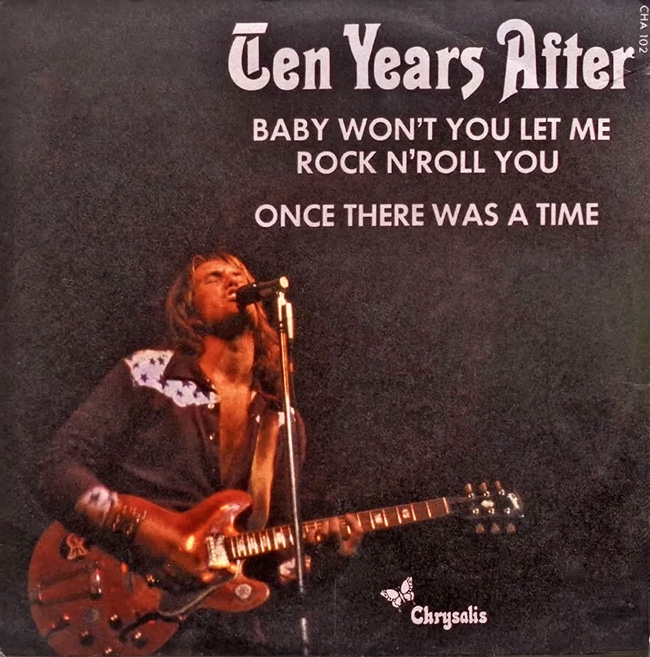
Single "Baby Won't You Let Me
Rock'N Roll You / Once Thee Was A Time" - France
|
Album Review – “A
Space In Time”
In which the rock
heavy (Alvin Lee) comes of age with his toughest, fullest,
and most coherent album. I like it, in a way, but it does
lack a certain winning abandon, and I’m not crazy about the
heavy’s economic theories – fellow (Alvin Lee) seems to
believe that if you “tax the rich to feed the poor” – you
soon run out of the rich, with dire consequences.
By Robert Christgau’s Record Guide
|
|
October 23, 1971 - New Musical
Express
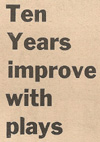
Ten Years
After – “A Space In Time” Album Review
When I first
heard this, it didn’t really grab me, but after awhile
I discovered quite a lot of interest in the music.
It’s well put together, but retaining a looseness here
and there for improvisation. Still Ten Years After are
a more important performing rock band than a recording
outfit, and so compared to live appearances, this LP
is just a little flat. But it does have variety,
something like a worn carpet, when you can say, oh
yes, I knew that bit was there, or I was expecting
that – predictable !
The opening
track, “One Of These Days,” has a rough rhythm and
blues feel, building up rock excitement, towards the
end. Then, “Here They Come” is more relaxed with
gentle vocals, and so the moods go – sometimes high
and pulsating, and sometimes down low (not musically
speaking) when the songs just groove along. But the
acoustic guitar openings did get a bit monotonous by
the end of the cuts, and on “I’d Love To Change The
World,” the intro brought back distant memories of the
As Tears Go By pattern. It was the Ten Years After I
like to hear on “Baby Won’t You Let Me Rock and Roll
You,” with a gimmicky radio tuning intro. Real sweaty
pigs music which no doubt gets a lot of teeth rattling
in a lot of shaking heads at concerts. Except for
“Uncle Jam” a revelation of Ten Years After abilities.
I was not over impressed by the second side. But the
jam number, seemingly thrown in to fill up the record,
is in the jazz vain, with some inventive piano playing
by Chick Churchill, a solid entente between bass and
drums and some fine jazz blues guitar patterns setting
the mood. Perhaps the whole set would be better
appreciated by a Ten Years After devotee though. – T.S. |
|
October
23, 1971 - Record Mirror
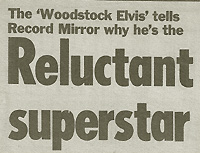
“The Fastest
Guitar in the West,”- “The Elvis Presley of the
Woodstock Generation,” – “King Guitar” (Bert Weedon
would dispute that – rock on Bert), these are just a
few of the back-handed compliments which have been
slung at the photogenic head of a man more sinned
against than sinning – Alvin Lee, guitarist with Ten
Years After. “I’ve never sought the super-star bit,”
said Alvin, reflectively sucking on a piece liquorice
wood (my misspent youth before sweets came off the
ration flashed before my eyes) as he sat in the
Chrysalis
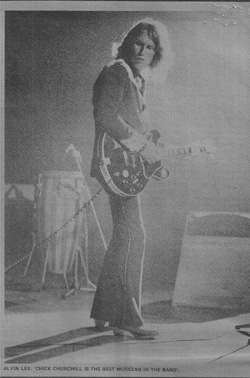 office
considering that which has been done on him from a
great height by some critics. office
considering that which has been done on him from a
great height by some critics.
“Apart from
anything else it is simple logic to avoid the face
cult, I spent some early days working in backing
groups, and I saw what happened to pop stars like Eden
Kane who were up there one minute and forgotten the
next. “Because I am the lead guitarist and because I
stand up front, I have come in for some special
attention, but I honestly believe that Chick Churchill
(organist) is the best musician in our band, I just
believe that so people can laugh at it if they like.
“Someone has to front for the band and I have found
myself edged into that situation, but I have not
sought it. Rod Stewart used to make jokes about the
band going to be called:
“Alvin Lee and
Company” but I noticed that he has been put in the
same situation with:
“The Faces,”
so maybe now he understands how it can happen. The
“Woodstock” film was partially responsible for some of
the misconceptions about the group. We seem to have
spent our playing careers trying to straighten out and
de-escalate these false impressions. The film had a
lot of people convinced that we were “I’m Going Home”
and that old rock syndrome that went with it, but it
was just one facet of the band. “I really don’t want
to have to justify my position as a guitarist, but all
this “Best” – “Fastest” – “Better” nonsense is
ludicrous to a musician. It just cannot be said that
Eric Clapton is better than Jimmy Page or someone
else.
It’s a
question of style and the type of music they play.
“This country has always been too anxious to compare A
with B and it’s really just so much schoolboy talk.
Now they are currently playing the game of who is the
best Beatle, it’s all so childish. Pop Polls are
almost as silly and insignificant and I’m told merely
reflective of what is happening in the charts at the
time. “I would never have the effrontery to rank
myself anywhere in a guitar poll, anyone who plays
guitar and gets paid for it must be good. All I really
want as a musician is recognition for the band and our
music. What I don’t want, is to encourage
adulation.
“The kind of
thing which really brings us up, is when someone
interviews us and shows that they know about our
records and material. We have now got the kind of
audiences who are prepared to listen and not leap
around up out of their seats. We don’t want glowing
reviews and glory, all we ask for is a fair hearing
and some real attention. Our last tour was encouraging
because it indicated that at last, that is what we are
getting”.
Article by
Keith Altham
|
|
October 30, 1971 - RECORD
MIRROR


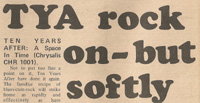
“A Space In Time”- Not to put to fine a point on it,
Ten Years After have done it again.
The familiar recipe of blues-cum-rock will strike home
as rapidly and effectively as have previous albums. “A
Space In Time” is, once again, all Alvin Lee originals
except for
"Uncle Jam,” the closing track composed by the whole
band – and they do the necessary, allowing Alvin
sufficient breaks to get in his licks and his three
compatriots their rock – steady backing support. Ten
Years After are most emphatically NOT a hard rock
band, exercising their musical prowess rather in a
more restrained way, and that, perhaps, is the one
drawback to this album. It lacks the fire and
excitement of Ten Years After “live,” for no matter
whether you like or dislike their music, you can’t
argue with the fact that they are an engrossing band
on stage. Lyrically and vocally, Alvin makes several
salient points.
One imagines that if he set his mind to it he could
write some fine ballads, but the blues is where his
heart is. -----Article by B.M.
|

30 October 1971,
Spectrum, Philadelphia - Concert Poster, Artist: Spencer
Zahn
|
THE RELUCTANT HERO – ALVIN LEE
„THEY THOUGHT I WAS DOING A GARBO“
From Melody Maker – November 6,
1971
|

|
|
A Super-Star sat in a darkened room and looked up
with hopeful eyes. Was it a day to be on the
defensive, or could he afford to relax? It was a
man from the photographic magazine. So Alvin Lee
could slump a little further into his chair and
discuss the speed of film instead of the rate of
his guitar playing. Ever since “Woodstock,” Alvin
has attained the oft-mentioned special status that
applies in rock as it once applied in Hollywood.
He has been lauded out of proportion to his talent
and slammed without fairness to his personality.
|
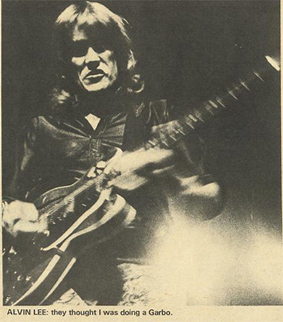 |
Alvin is a good, entertaining rock guitarist with
an enthusiastic band who happen to be one of the
longest surviving from the group-boom of the
mid-sixties. Long before the United States rock
press called him “Mr. Album Cover,” Alvin was down
at the Marquee, in London, bringing excitement to
the masses as they are today. But Alvin, Ric Lee,
Leo Lyons and Chick Churchill were grooving quite
happily.
The attempt to make Alvin a star embarrassed him
and brought confusion to the group. It almost
brought them to the verge of breaking up.
Moody album shots, featuring Alvin were the vogue.
|
“People began to think I was some kind of Greta Garbo,”
grumbles
Alvin in his soft Midland accent. And he refers
to the “super star bit” with patient resignation.
Alvin’s great hobby is photography and he was
extremely pleased and flattered that a specialist
photography magazine was to (a) interview him, and (b)
use his work for a photo-spread. In fact, the
interviewer went on at such length, most of the staff
at Chrysalis headquarters were busy listening at the
keyhole in amazement. “He’s been in there for hours”!
Breathed a secretary.
Eventually the photographers friend filtered out and
Alvin began to focus his attention on the subject of
rock. “I’ve just got into printing,” he revealed,
stretching, then burrowing further into his chair.
“I’ve been taking photographs for quite awhile. I took
about a thousand slides on the last tour. I think
about a half a dozen came out. I’m into movies as
well, and I’m hoping to get sound sync together. It’s
more to entertain friends. I don’t think a public
viewing is imminent ! I like to project different
moods on to film and use sound effects and music to
create atmosphere. Our new album is leaning that way”.
What was that powerful hum at the start of the album?
! It’s backward strings over a heavy chord. The idea
is to draw people into the album. People often give me
the impression they review our albums from halfway
through. Some of the comments have been: “There is a
great rock and roll track,” which is the climax of
side one. But our rock and roll stage act has been
well publicised and we are trying to branch out. Rock
comes easy to us, like second nature,” How did Alvin
feel about his past albums? Did he ever listen to any
of them? “I don’t play them usually. After I’ve
finished an album I go off it. I hear all the
mistakes. But after six months, if I put them on, I
surprise myself! Our “Live” album is still the most
satisfying. A lot of people who have come to listen to
us since “Woodstock” were not familiar with what we
did in our formative years, like the “Undead” album,
and the jazz jams”.
What was Alvin’s image in America?
“Woodstock” freaked us out, in that it gave us an
audience of youngsters who were not really into our
music. And I’ve always been a bit embarrassed about
the old super-star tag y’
know”. A look of yearning passed over Alvin’s
not unprepossessing features, as if he would rather be
pottering about in the garden, photographing small
winged insects.
“We try to encourage people to listen to our
music and not be too pretentious about it. The main
function of Ten Years After, I like to think, is
to entertain, through our musical ideas. I don’t
really associate with any image of Ten Years
After. I’ve long ago given up trying to suss how we
come over”.
Was there still friction within the band?
“It’s like married life. We’ve been through a lot of
hassles and most of it was through, misunderstanding
over the old super-star tag. I thought it was cool,
but a lot of people got the impression I was doing a
Greta Garbo and trying to be a star. But you have no
control over what people think. Someone somewhere will
think bad of you. I don’t think an artists will be
concerned with his image if he believes in what he is
doing. “I was very pleased with our last English tour.
The last one we had done, the idiot dancers were all
the rage and the concerts were like a big circus. On
this tour I was pleased to note it was a very
attentive audience. They were interested in the
musical structures we were building. And it was great
to have control over our equipment. You can’t just
have a good P.A. these days, you have to know what you
are doing. We’ve been building ours for two years. It
must be very difficult to start a band these days,
when the audiences hear the sophisticated equipment
used by top bands.
“When we started out, the Beatles had one
hundred watts. Not it’s out of all proportions. We
take so long over the quality control of an LP we have
to get as good a sound live. “It was a very short
tour, but we were not sure how it would go down here.
The reason we’ve been away so long is that we wanted
to have really good equipment, like the stuff we use
in the stadiums in America. There they book a PA for a
concert in the same way they book a group. In England
we wanted similar equipment. It was easy in the old
days at the Marquee where you could get a big sound right at the
back. You were practically inside the band anyway.”
I reminded Alvin of his first big concert at London’s
Sayville Theatre in the days of Brian Epstein
promotions. “Yeah, we did “Help Me Baby,” just one
number. And it got a mixed reception. At the time,
that long number seemed like the biggest mistake we
have ever made!
Yeah, Jimmy James and the Vagabonds were topping.”
Did Alvin think the age of the rock guitar hero was
drawing to a close? Peter Green has given up the
business. Eric Clapton is hiding in obscurity. Jeff
Beck has been out of action. Apart from Rory
Gallagher, Alvin is still out there socking it to us,
and where were the new heroes?
“It’s true that era is over. There is so much more
good music now, though. We all came from the same
environment and had the same influences, Scotty Moore
with Elvis
Presley etc. Nowadays the new guitarist have so much
music to draw from it’s unfathomable. It’s incredible
to me when people say rock and roll is on the way
down. It’s not. The music has spread in all
directions.
Why do the guitarist become so popular?
“I really don’t know. It was a kind of wave. Jimi
Hendrix was the great innovator and he showed
everybody the way, and how much there was to the
guitar. His control of feedback was incredible”.
When Alvin took his share of fame, he took his share
of criticism. How did he face up to the mixed
blessings of stardom?
“Criticism is a by-product of the rock scene. Rolling
Stone gave such a slamming of our last album, it was
such a put down that I had to burst out laughing. It
was as if they had picked on every bad thing. But I
don’t have to protect myself in that way. Some people
hate us, some like us, and some couldn’t care less.
I’m concerned with the people who like us, and I get
my feedback from them. “I used to wonder how I had
crossed people that they should form such bad opinions
of me. I suppose the music business has the tendency
to create superstars, but I really don’t believe in
such a thing. I used to when I was a kid and I was an
Elvis Presley fan. Whenever I’ve met a star, they’ve
turned out to be quite Norman people. And the magic
doesn’t exist.
“I went to see Elvis in Las Vegas and it freaked me
out badly. He was throwing teddy bears to the audience
and had a supply of neck scarves he took off and threw
to them, it was fifteen quid a seat and it was really
disgusting. Superficially silly! The music had no
balls at all, but the potential is still there. He was
just coasting through his act and it seemed like it
was just another gig. It can happen to any artists. We
started coasting after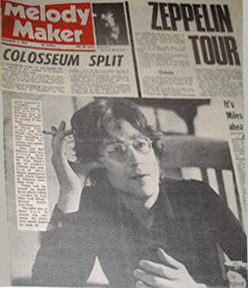 “Woodstock,” and whatever we played went down well !
But you’ve got to hang on by your teeth and try.
“Woodstock,” and whatever we played went down well !
But you’ve got to hang on by your teeth and try.
“All bands should be given a chance to mature and
change. And you have to follow what you feel. We are
still experimenting. If I took seriously all I read
about me, I’d really be in a bad state.
“As for the money, that’s a reward for perseverance.
If you want to be a millionaire, don’t be a rock and
roller. I remember when we overtook the Rolling
Stones. It was on the M1 – and we were both in 15 cwt
vans”.
By Chris Welch
|
|
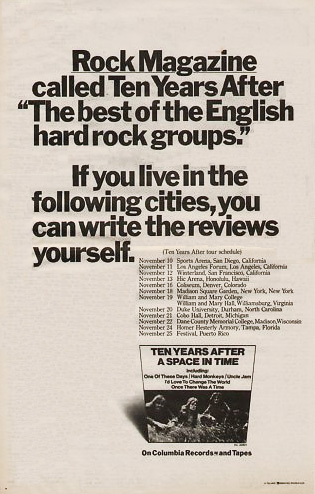
|
1971
November 10th – Sports Arena – San
Diego, California
November 11th
- Los Angels Forum – Los Angels, California
November 12th - Winterland,
San Francisco, California
November 13th
- HIC Arena, Honolulu, Hawaii
November
16th - Coliseum, Denver Colorado
November 18th – Madison Square Garden,
New York, New York
November 19th
- William and Mary College
November 19th
- William and Mary Hall – Wellsburg,
Virginia
November 20th
- Duke University, Durham North Carolina
November 21st
– Cobo Hall, Detroit, Michigan
November
22nd – Dune County Memorial College –
Madison, Wisconsin
November 24th
– Homer Hesterly Armory, Tampa, Florida
November 25th – Festival, Puerto-Rico |
|
“I saw them on November 11, 1971
at the Los Angeles Forum.
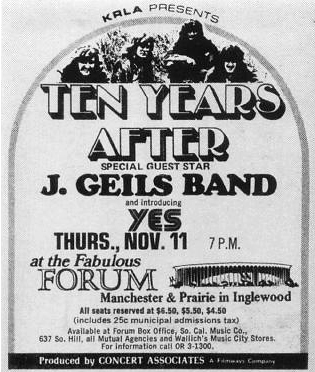
The band “Yes” opened the show, J.
Geils Band was next and Ten Years After were the
Headliners” closing the show”.
Ten Years
After:
The L.A. Forum
in Inglewood, California. Ten Years After, who have
been playing together for about five years, are
beginning to look a little bit frayed around the
edges. Make no mistake, the standing room only
audience at the Forum loved them, but it appears to be
a form of pre-programmed-monotony. The group members,
led by singer / guitarist Alvin Lee are all excellent
musicians but they are given to excess by stretching
their numbers out, to the point of becoming
meaningless repetition. They performed mostly older
material, not really something upon much of anything
from “A Space In Time,” which was a pity, as that is
their most diverse album to date. They are superstars
now, but for how long? If they don’t expand their
musical range.
The J.Geils
Band:
Boston’s J.
Geils Band, certainly do know how to Rock & Roll. They
are a hard pulsating group and had the audience
dancing in the aisles. Lead singer Peter Wolf, a
subscriber to the Jaggeresque school of movement, has
a robust electrifying voice. Their set was highlighted
by a knockout version of, “First I Look At The Purse”
and their new single, “Looking For A Love”.
YES:
Yes, is that
odd little gem of a group whose music evokes images of
long ago and visions of what is yet to come. Their
music is explosively powerful yet wistfully gentle;
progressive rock that is classically influenced. All
are highly skilled musicians and they are a joy to
hear.
A special
treat is lead singer Jon Anderson who has a tenderly
exciting, emotion-filled voice and a jaunty stage
presence. They performed a stunning set comprised
chiefly of material from “The Yes Album” including
their hit single “Your Move”
Review by Shelly Heber |
|
Bill
Graham presents
September - December 1971

Winterland, San Francisco, 12
November 1971
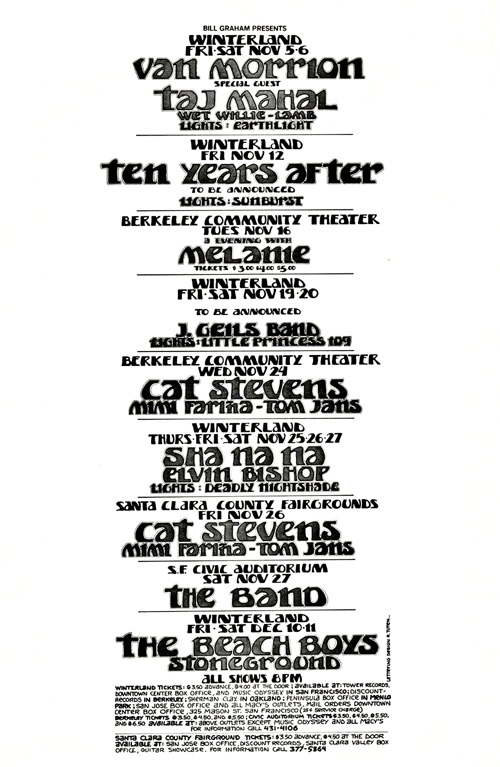

20 November, 1971, "Duke
University", Cameron Indoor Stadium, Durham, North
Carolina

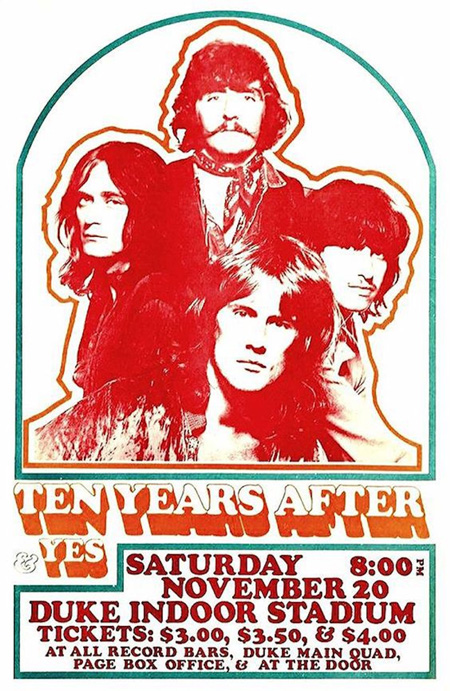
|
|
CIRCUS MAGAZINE - November 1971
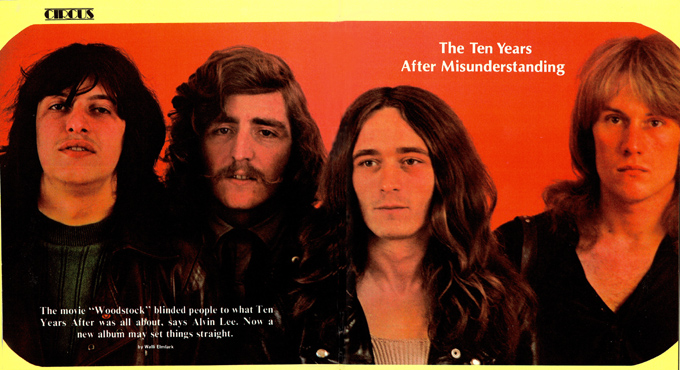
“THE´TEN YEARS AFTER MISUNDERSTANDING”
The movie “Woodstock” blinded people to what Ten Years
After was all about, says Alvin Lee. Now a new album
may set things straight.
Article written by Walli Elmlark
Thirteen thousand kids watched a full summer moon
ascend over Gaelic Park in the Bronx N.Y. Blankets,
beer, booze and smoke filled the “up” and expectant
atmosphere, punctuated here and there by the cry of
the vendor. No, not hot dogs and soda. mom. Those days
are long gone. “Incense! All kinds of incense here.”
The occasion: Alvin Lee and Ten Years After. Alvin
Lee, known as the fastest guitarist of today. But
Alvin doesn’t think that’s the reason people should be
coming to see him.
“I am fast “said Alvin in an office at
Columbia Records. His eyes slipped to his clogs and he
continues. “but I don’t aim at being fast. Fast for
fast sake means nothing! I mean I could sit home all
day and just practice being fast and I could play
faster than I do now. But that’s not the idea, I use
that fastness as a contrast, like lights and shadow.”
Alvin feels that people began to lose sight of the
“lights and shadows” after the movie of Woodstock
showed Ten Years After sizzling the stage with the
hard lightning of “I’m Going Home.” Since then says
Alvin, they’ve been met at every concert by audiences
who’ve already worked themselves up to a fever pitch
before anyone’s set foot on stage. But contrary to the
reaction most groups would have to this instant
popularity, Alvin and the boys have gotten quite
unhappy about it. Alvin asked me to make it very
clear, that at the time
“Woodstock” came out, the group already had
five albums on the market. He doesn’t think that the
frantic drive of “I’m Going Home” is representative of
the group’s music. He wishes now that they had hit the
movie screen with something
quieter, like “I Can’t Keep From Crying.” And
he’d rather trade in the overheated post-Woodstock
audiences for a cool, slightly reticent crowd that’s
going to listen to the music before it begins to
cheer.
From this one group, to whom the amount of money and
the amount of screaming means absolutely nothing,
unless they feel they’ve won it musically at each gig.
“We could be making any amount of money at a gig, and
the kids could be tearing the roof down, but if we
leave the stage, feeling we were not as close to
perfect as we can get, we’re depressed and upset.,
until the next time when we do it right!
Alvin comes close to fetishism in this need
for musical perfection. “A car could run
up and down his guitar, like lightening “ he
said, speaking of his legendary speed . “but be
missing notes very often. Fastness would mean nothing
to me without accuracy.”
“As far as sets go, we know the kids are happiest
hearing the songs they know best like – “Good Morning
Little School Girl” and “Love Like A Man”, but that’s
the easy way out. We could get up there and lead off
with those songs and have the place roaring, but
that’s not where we’re at. We’re constantly changing
and moving ahead, and that’s the important thing. So
we’ll go up there and play cuts from our new album and
work for their approval”.
The group’s new album, “A Space In Time” (on their new
company Columbia), will be their seventh. When asked
how it differed from the others, Alvin said, “Well
first of all it took literally ten times longer to
record. All the others took about two weeks. This time
we wanted to take our time and be really happy with
the final product.”
Do you feel the extra time you took has made a
substantial difference? “Very definitely. We’re quite
pleased with the outcome of the album. Much more than
with any other. It’s very hard to discuss it now. It
seems once we’ve cut and finished an album it’s in the
past and over.
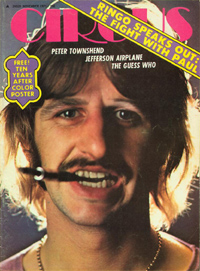
Would you believe I’ve only listened to it twice since
we did it?”.
“The one cut on the album that’s a total departure for
us is: “Over The Hill”. For the first time we used
musicians other than just the four of us. We used
eight violins and four cellos. Before you think we’ve
gone balmy, I better explain, that it’s a song about
over saturation and the strings are brought in at the
end to demonstrate our point…..definitely over
saturation.
“So many producers feel the need to fill in every gap
or hole in a song. We’re all for holes (smile). But
we’re fortunate in that we produce ourselves and have
the say over every aspect of our album, from jacket on
down”. As a matter of fact Alvin has stopped shipping
on the new album just because the jacket had several
flaws. The blonde guitarist looked back at the carpet,
then detoured from the subject of the album. “Our main
concern when writing is the musical content, and the
lyrics are secondary. We like to stay loose and keep
the musical creativity alive. Which is why we have no
set arrangements on our songs. When we’re touring
we start with the basic patterns, go into a
jam, then come back for the finish. That’s why we
don’t get stale. But with the same song to do so
often, even the jams get to sound alike after awhile.
That’s why we quit touring for three months last year.
Then all these rumours started going around that we’d
split up. Nothing could be more wrong. We quit because
we were beginning to fall into the same jam, and when
that happened two nights in a
row, we knew it was time to go home and work on
something new.
“How do you feel about jamming with other groups”?. “I
jammed once in England with Jimi Hendrix and a couple
other musicians, I can’t remember just who right now,
but I found it very frustrating. The problem was that
each one of us had our own very definite style and it
was difficult for us to mesh them all together. I’m
used to jamming since that’s how we do all our songs,
but we’re so together musically that everything just
flows, no one cuts you off in the middle of a riff or
leaves you hanging with nowhere to go. It would feel a
little childish to walk up to Hendrix and say, “hey,
I’m not done – wait a minute”. Also I find if I listen
to another guitarist, like Eric Clapton for awhile,
I’ll find myself, without consciously realizing it,
playing some of his riffs. That’s not good”.
The subject of today’s guitarist brought up the
question of which ones Alvin feels are the best.
“That’s really hard to answer. Guitar playing today
just isn’t near what it used to be back in the blues
days. Those guys were really great. They could play a
twelve bar progression without repeating themselves.
What about you Alvin?.
“Well, I try. If I had to name a couple, I guess it
would be George Benson and Steve Stills. Steve does
some nice things”.
When the members of Ten Years After jam, they work
together like the two halves of a heart. Partly
because Alvin Lee and Leo Lyons have been playing
together for ten years.
“Did you go to school together?” - “No”
“Were you from the same neighbourhood ?” – “No”
“Friends?” – “No”
“Enemies?” …….
“I answered an ad in a paper one day, that said lead
guitar player wanted”, Alvin finally answered, his
eyes retreating again to the comfort of his clogs.
“Leo was in that group, which stayed together for two
weeks. When they split, Leo and I stayed together. We
played a few gigs as “Raving Dave and the Rocking
Daddios”, Nifty, huh?” The group as it is today, has
been together close to five years. Since Alvin was
wearing a “Fillmore”
T-Shirt and the place had been one of his
favorite gigs, it seemed only appropriate to ask him
how he felt about the Fillmore closing. “Actually, it
didn’t come as any surprise to me. Ever since I met
Bill Graham, several years ago, he’d been saying he
was going to make his money, and get out. Actually,
that’s not why he closed. The hassles were just
getting too heavy. I respect Bill a great deal, he set
up a model for giving rock concerts that was copied
all over the country.
Unfortunately, they came off as copies, because not
one was as professionally run, not one had the same
atmosphere, and not one had the fantastic sound system
that the Fillmore had.
The Fillmore Audience had changed by the time Bill
closed it. Even we noticed it. To us it appeared to be
a shift in age. The 18 and 19 year olds weren’t
showing up anymore. It didn’t really bother us,
because when you’re 18 – 19 and into rock concerts
that’s great. But hopefully as you get older, your
interest progress to other things.
“The majority of people in the audience seemed to be
thirteen or fourteen, but that was alright with us
too. Since we care so much about the musical content
of our act, and very little about being pretty, or
just jumping around the stage a lot, the 13 year olds
are great because we can teach and guide them
musically”.
“A Grand Funk Railroad will get their interest
instantaneously. They’re like avant-garde art :all
bold, brash, loud and one dimensional without the
undertones and nuances of fine art. For us to get
those thirteen and fourteen year olds to listen and
understand gives us our feeling of accomplishment in
music. “We can’t stand hype or sensationalism. That’s
why we give so few interviews. Also, we absolutely
refuse to do any television, even though it guarantees
record sales. (We’ve never had a gold record you know)
That’s just not our way of doing things”.
Which brought up the problem of a movie called
“Groupies”. There the filmmakers not only put Ten
Years After on the screen, but they gave the
impression that the group spends half of its time
luring little girls away from home, then dropping them
off in the middle of nowhere.
“Yes, well that was a mistake” said Alvin. “Actually
we were misled by the producer. We were told it was to
be a documentary called “Rock 70”. “Let me just say
this”, interjected Leo Lyons, breaking his long silence.
“It’s unfortunate that our music had to be associated
with such crap”. “Since that word has arisen of its own
accord, I’d like to set the record straight”. Alvin
said. “On a rumour I’ve been hearing about, I am not
now, nor have I ever been married. I also do not have
the child or children, I am reported to be hiding. “It’s
incredible what one learns about oneself that one never
knew”. One thing few people know about Alvin Lee, is
that he is quiet, soft spoken and verges on outright
shy. When he talks, his eyes look aside to the carpet,
the desk where his coffee sits, or the wall across from
him. Then, suddenly, he looks directly at you, and
through his eyes are small, a blast of blue sunshine
smiles from them and you find you’re smiling back. When
the questions are over, he slips into an almost bashful
silence, and it’s hard to realize he’s the same Alvin
Lee who, when he left the stage at Gaelic Park, had to
be protected by ten body guards to keep the screaming
mobs away.

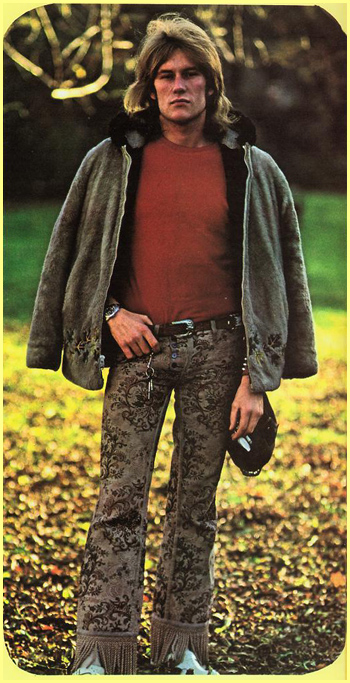
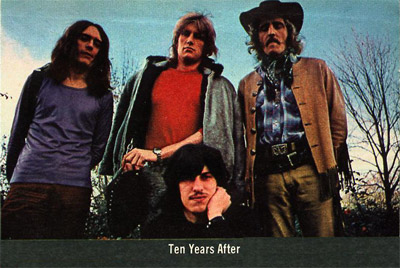
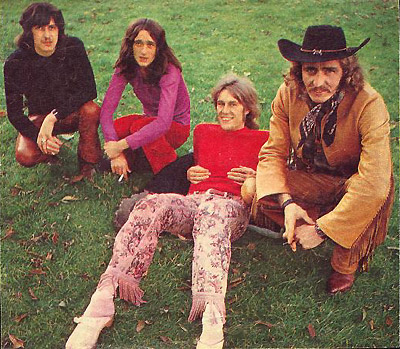
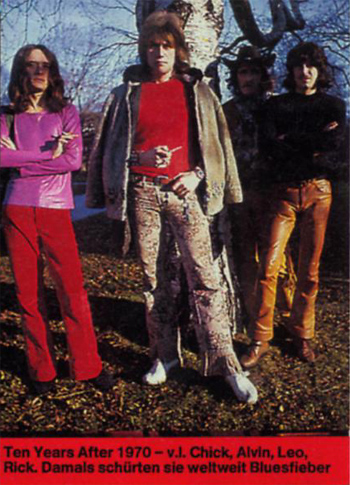

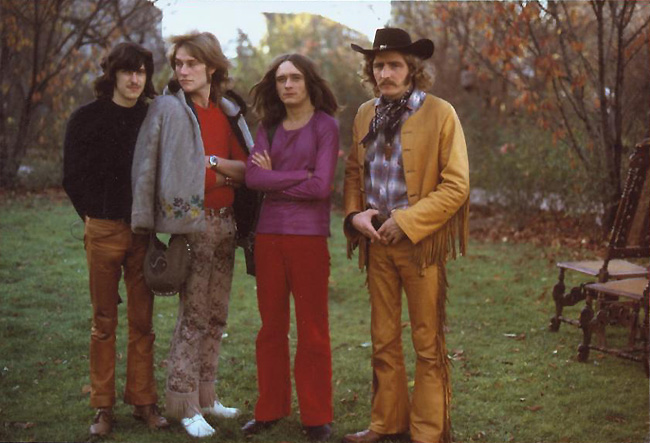
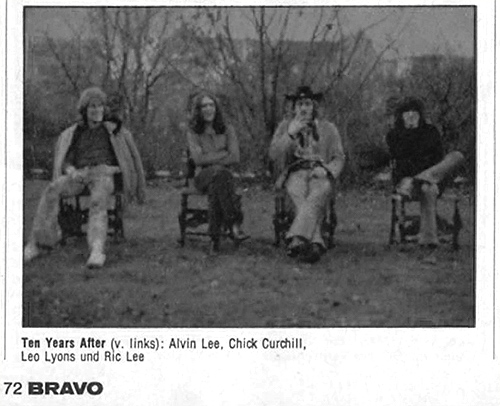

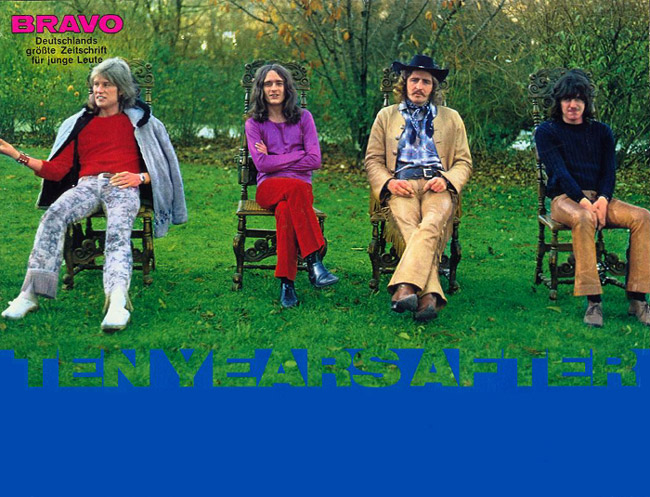
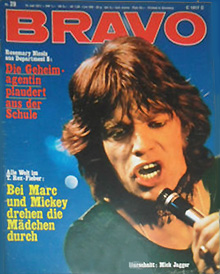
BRAVO 1971 |
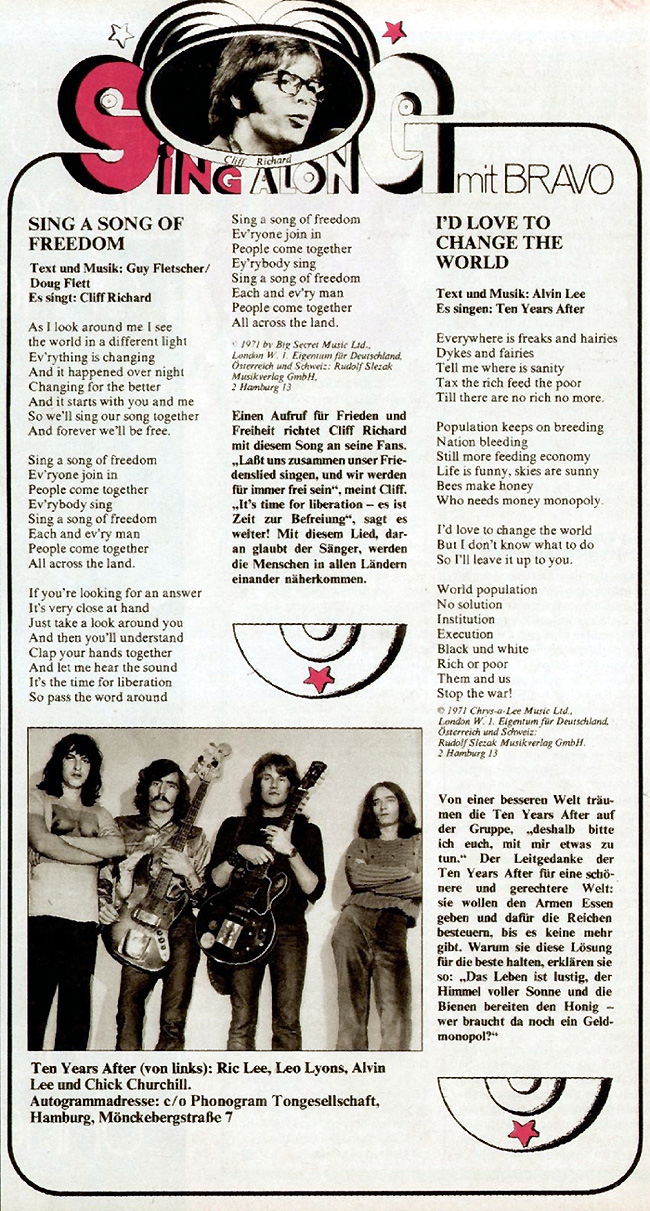

November 1971 -
Musik Express Magazine, The Netherlands

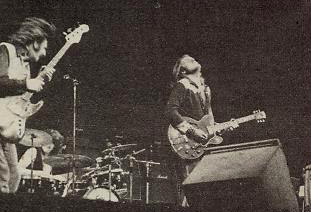


One of my favorite "on stage"
photos of Ten Years After - 1971 - With conga drums for
Chick Churchill to bang on!
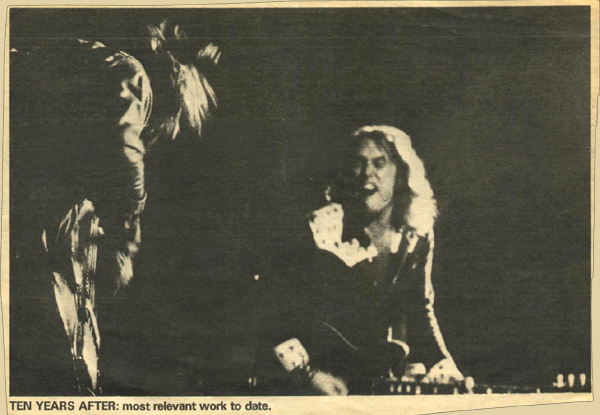

Ten Years
After hit their peak. "It really was a heads down let's go
for it attitude.
Leo used to shake his head off", says
"Captain Speedfingers" Lee.
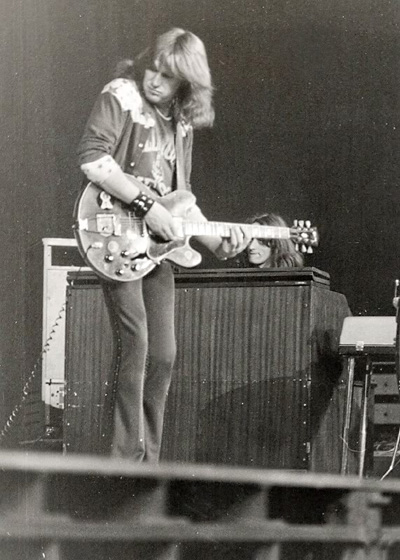
Deutschlandhalle, Berlin 1971
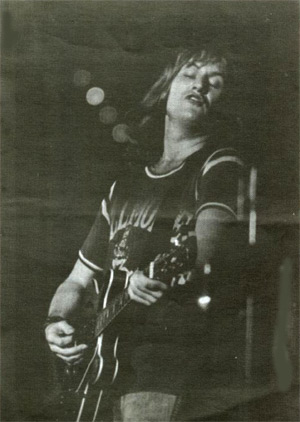
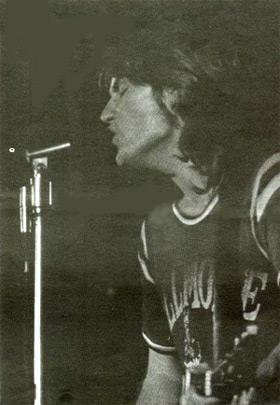
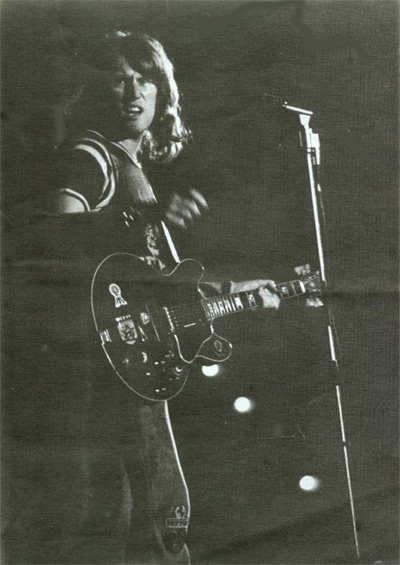
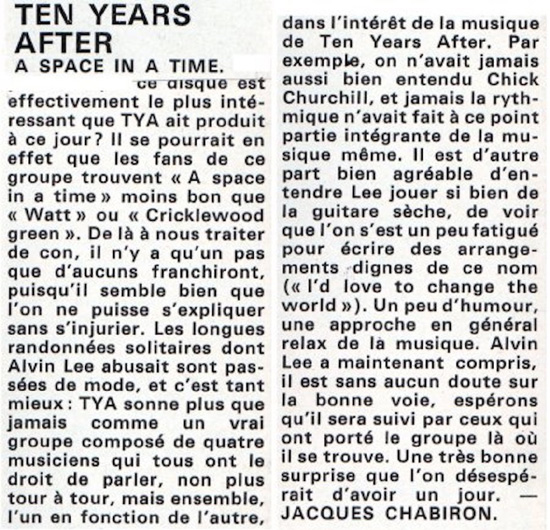
Rock & Folk No. 59, December 1971
|
New Musical Express
December 25, 1971
 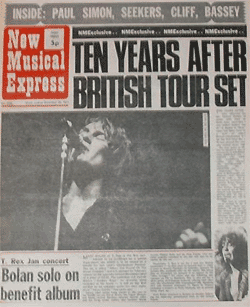
|
NME - London Special
Issue |
NME - Standard Issue |
New Musical Express – Around London -
December 25, 1971 – Stroll On:


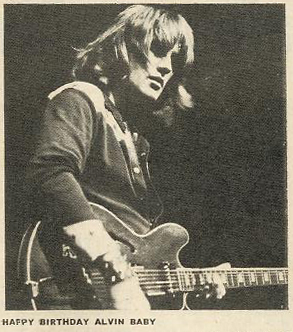
Pushing my
way through the Christmas shopping crush at Oxford
Circus tube last week, who should I meet pushing in
the opposite direction but carol Grimes of Uncle
Dog. The now Uncle Dog album, she told me, is almost
completed. “We’ve got some very good session
musicians playing with us…Paul Kossoff, David Linley,
and Nicky Barclay, Fanny’s organist… and Bob Porter,
and the guy who did so much for Bell and Arc, is
producing it”.
When I got
back to my office, I rang Lionel Conway, whose
company publishes Uncle Dog’s music and who
generally looks after the affairs of the group. So
far, he hasn’t signed them to a label, but already
he has had plenty of offers. “Just a question of
sorting the wheat from the chaff,” he told me. The
group is doing very well at the moment, drawing
fantastic crowds to every performance”. New Years
gigs for Uncle Dog include the Greyhound in Croydon
on January 2nd , High Wycombe Town Hall
on the 7th Implosion on the 9th,
and on the 13th they are at the Marquee.
Uncle Dog are an exceptional band. If you are free
on one or all of those dates, a journey to visit
them would be well worth taking.
A few years
ago B.P. Fallon, T. Rex’s publicist gave me a very
beautiful album, which I still have in my
collection. It’s called, “The Playboy Of The Western
World”. Sean O´ Riada who died a few months ago,
wrote it as the score to a film of the same name.
The music is from Ireland and is very traditional,
lots of pipes, hand-drums and double-row button
accordions, and of course, two “very fine” fiddles.
Some of the numbers have vocals, and one in
particular, the last on the first side, is an Irish
jig that makes East Of Eden’s “Jig-A-Jig sound very
watery. Though the album is very easy to purchase in
Ireland, it is much more difficult to obtain in this
country (England). However, there is a record shop
at 161Arlington Road, Camden Town, called The Irish
Record Centre. The lady who runs it is called Kay
and she told me she has hundreds of excellent Irish
records, besides Sean O´Riada and invites you to
come and have a look. If you want to make sure a
particular record is in stock, please call ahead
first.
Last
Tuesday, I rang Alvin Lee, who had just returned
from another American trip, to find out how he was
and what was happening with him and his lovely lady
Lorraine. “Everything’s fine,” said our Alvin. “Ten
Years After are going to France in January 1972, for
some recordings, and we’re planning a production
company of our own, producing groups and singers
that we like, but so far it’s only in the talking
stage”. It was Alvin’s 27th birthday last
week. December 19, 1971.
By Count Simon Christian
Dominic Huchet De La Bedoyere
|
|
Ten Years After Equipment
(1971)
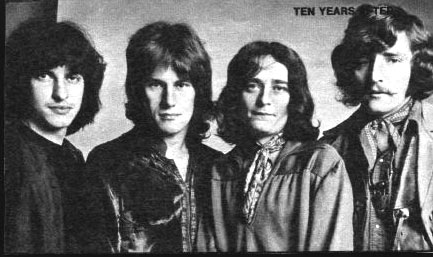
PA:
5 - 100 watt Marshall amplifiers
12 - 100 watt Marshall cabinets
1 Fender twin Reverb
2 Acoustic 360E bass amplifiers
2 Lashramme speaker cabinets each containing 36 - 4/12
in. speakers, handling capacity per cabinet 560 watts rms.
4 A7 Bass Reflex cabinets 1 - 15in speaker per cabinet,
handling 35 watts per speaker.
10 SRO speaker cabinets 2 - 12in speakers per cabinet,
handling capacity 60 watts per speaker.
2 SRO speaker cabinets 2 - 15in speakers per cabinet,
handling capacity 65 watts per cabinet
1 Teletronix leveling amplifier LA2A.
3 Crown DC 300 amplifiers, each Crown has a stereo
amplifier of 300 watts per channel rms.
|
GUITARS:
1 Fender Stratocaster guitar.
2 Gibson 335 stereo (1 cherry red,
1 sand color) guitars.
1 Eko 12-string Ranger guitar.
1 Fender Telecaster bass guitar.
1 Rickenbacker bass guitar.
STRINGS:
fender/Gibson Sonomatic mixed strings.
Labella heavy guage bass strings.
ORGANS/PIANOS:
1 Hammond M102 organ
2 Hammond B3 organs
1 RMI 300B electric piano
1 Steinway grande piano
MICROPHONES:
6 ShureUnisphere 565
5 Shure Unidyne III
1 Beyer 260
1 Electro Voice
12 AKG microphone stands
|
DRUMS:
2 Gretsch drum kits:
1 Gretsch Black Pearl drum kit consisting of:
1 - 24" x 14" bass drum
1 - 61/2" x 14" snare drum
1 - 13" x 9" top Tom Tom
2 - 16" x 16" side Tom Toms
1 Gretsch Maple Wood drum kit consisting of:
1 - 20" x 14" bass drum
1 - 5" x 14" snare drum
1 - 12" x 8" top Tom Tom
1 - 14" x 14" side Tom Tom
CYMBALS:
2 Avedis Zildjian cymbals
2 - 15" Avedis Zildjian Hi-Hats
4 - 16" Avedis Zildjian crash cymbals
2 - 19" Avedis Zildjian ride cymbals
1 Hi-Hat Ching-ring
|
|
|